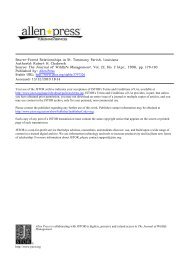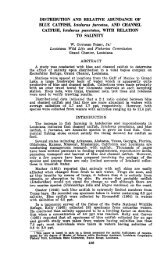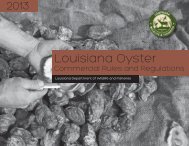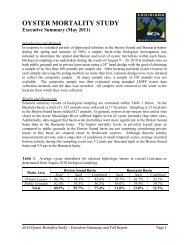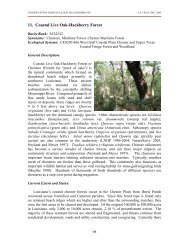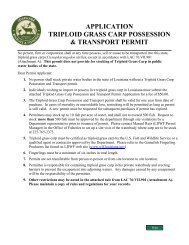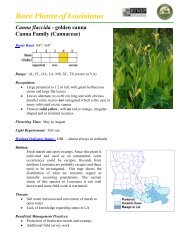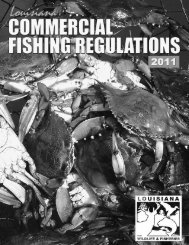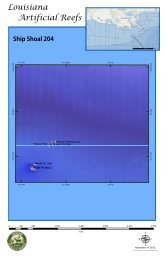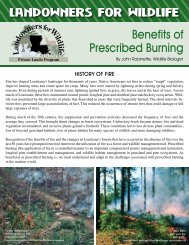2010 Wild Turkey Report - Louisiana Department of Wildlife and ...
2010 Wild Turkey Report - Louisiana Department of Wildlife and ...
2010 Wild Turkey Report - Louisiana Department of Wildlife and ...
- No tags were found...
Create successful ePaper yourself
Turn your PDF publications into a flip-book with our unique Google optimized e-Paper software.
<strong>2010</strong> <strong>Louisiana</strong><strong>Wild</strong> <strong>Turkey</strong> <strong>Report</strong>
<strong>Louisiana</strong> <strong>Department</strong> <strong>of</strong> <strong>Wild</strong>life <strong>and</strong> FisheriesNational <strong>Wild</strong> <strong>Turkey</strong> FederationOctober <strong>2010</strong>Publishing cost funded by the <strong>Louisiana</strong> Chapter <strong>of</strong> theNational <strong>Wild</strong> <strong>Turkey</strong> Federation
A Message from the SecretaryThe wild turkey population in <strong>Louisiana</strong>, once in decline, has been replenished through the dedicated efforts<strong>of</strong> <strong>Wild</strong>life Division biologists <strong>and</strong> support staff <strong>of</strong> the <strong>Louisiana</strong> <strong>Department</strong> <strong>of</strong> <strong>Wild</strong>life <strong>and</strong> Fisheries.As a result, outdoorsmen <strong>and</strong> women enjoy the hunting opportunities provided in <strong>Louisiana</strong> from earlySeptember dove season through small game, deer <strong>and</strong> duck season, <strong>and</strong> then turkey season annually inMarch <strong>and</strong> April.I remember my first wild turkey taken at the age <strong>of</strong> 12 with a bolt action .410 shotgun near Oak Ridge on ahunt with my father <strong>and</strong> many enjoyable spring turkey hunts in the years since. The steady improvement<strong>of</strong> our state’s turkey numbers since restocking began in 1962 have brought more hunters into the ranks <strong>of</strong>turkey hunting enthusiasts. The most recent hunter surveys indicate there are about 18,000 resident hunterswho participate in the annual spring season.Progress continues to be made on habitat restoration throughout the state, <strong>and</strong> that effort should bolsterwild turkey numbers in the years ahead. It is my hope that the worst Gulf hurricane seasons in recent history<strong>and</strong> the worst man-made environmental disaster in this country’s history are behind us, so that recoverywork can continue uninterrupted. Habitat management is the primary mission we serve, <strong>and</strong> our fieldstaff resources need to be focused there in the years ahead.Robert Barham, LDWF SecretaryPhoto provided by Robert Barham
Contents2Introduction34<strong>Wild</strong> <strong>Turkey</strong> Program Leader’s<strong>Report</strong>By Jimmy StaffordNational <strong>Wild</strong> <strong>Turkey</strong> Federation<strong>Report</strong>By Luke LewisBobby Jindal, GovernorRobert Barham, SecretaryLois Azzarello, UndersecretaryR<strong>and</strong>y Pausina, Asst. SecretaryJimmy Anthony, Asst. SecretaryJohn Roussel, Deputy Asst. Secretary5<strong>Louisiana</strong> <strong>Wild</strong> <strong>Turkey</strong> <strong>Report</strong>Population Status 6Reproduction 6Restoration 8Hunting Seasons 9Statewide Harvest 10Division AdministratorsKenneth Ribbeck, <strong>Wild</strong>lifeRobert Love, Coastal & Nongame ResourcesJoey Shepard, FisheriesCol. Winton Vidrine, Enforcement1329<strong>Wild</strong>life Management Areas<strong>Turkey</strong> Hunting on WMAs 14WMA Harvest Histories 15WMA Youth Hunts 27Research & Management<strong>Wild</strong>life Division Directors/ManagersScott Longman, Director <strong>of</strong> Habitat StewardshipFred Kimmel, Director <strong>of</strong> Education & Technical ServicesR<strong>and</strong>y Myers, WMA Program ManagerJohn Robinette, Private L<strong>and</strong>s Program Manager333637<strong>Louisiana</strong> <strong>Wild</strong> <strong>Turkey</strong> RecordsConclusionAppendicesAppendix A. <strong>Louisiana</strong> Forest Habitat Overview 38Appendix B. <strong>Louisiana</strong> Poult Production Index 39Appendix C. B<strong>and</strong>ed Gobbler Harvest Rates 40Appendix D. Tag Validation Date Comparisons 41Appendix E. 2009 <strong>Report</strong>ed Harvest by Parish 42Appendix F. <strong>2010</strong> <strong>Report</strong>ed Harvest by Parish 43<strong>Wild</strong>life <strong>and</strong> Fisheries CommissionersStephen J. Oats, Lafayette, ChairmanBilly P. Broussard, KaplanRonny Graham, ChoudrantPatrick C. Morrow, OpelousasStephen Sagrera, AbbevilleAnn L. Taylor, LulingMike Voisin, HoumaFront Cover: James C. DavisBack Cover: David Morel<strong>and</strong>
IntroductionDuring the years following World War II, <strong>Louisiana</strong>’s wild turkey (Meleagris gallopavo silvestris) population was at its lowestpoint. In 1946 it was reported that only 14 isolated flocks totaling less than 1,500 wild turkeys remained throughout thestate. Biologists feared that the population might become completely extirpated from the state. This prompted efforts tobolster dwindling numbers with pen-reared “wild” turkeys, a project that was ab<strong>and</strong>oned after several years <strong>of</strong> failure. Bythe 1960s, advances in cannon net technology allowed wildlife managers to trap native wild turkeys for restocking. <strong>Wild</strong>turkey numbers soon began to increase. Most <strong>of</strong> <strong>Louisiana</strong>’s restocking was accomplished from the mid 1960s throughthe late 1990s. During this period <strong>of</strong> success, many farms left fallow were planted with trees during the Great Depression,which matured into suitable habitat ripe for an exp<strong>and</strong>ing turkey population. The word “conservation” took on newmeaning for many older hunters that lived through the lean years <strong>and</strong> wanted something better for the next generation.Conscientious l<strong>and</strong>owners from areas where turkeys occurred graciously shared this precious resource for restocking areas<strong>of</strong> the state where they did not exist. During this same period many large industrial timber company forests formerly opento unrestricted hunting, were leased to hunting clubs serious about result-oriented wildlife management. Citizens acrossthe state worked together with the <strong>Louisiana</strong> <strong>Department</strong> <strong>of</strong> <strong>Wild</strong>life <strong>and</strong> Fisheries (LDWF) to protect newly establishedturkey populations both on public <strong>and</strong> private l<strong>and</strong>s. Countless LDWF employees worked day <strong>and</strong> night during these “restocking”years, led by wild turkey program leaders like Dan Dennett, Danny Timmer <strong>and</strong> Larry Savage. Numerous regionmanagers, biologists, wildlife technicians, other LDWF employees, <strong>and</strong> volunteers unnamed in this report are the true unsungheroes <strong>of</strong> this effort. Through trials, tribulations <strong>and</strong> toil, they overcame many obstacles to make it happen. Anothermajor partner in this effort was the National <strong>Wild</strong> <strong>Turkey</strong> Federation (NWTF). Each year NWTF fund raising banquets occuracross the state to raise money for wild turkey conservation. National, state <strong>and</strong> local NWTF chapters continue to support avariety <strong>of</strong> <strong>Louisiana</strong> turkey projects. By funding equipment, habitat work, education, research, <strong>and</strong> even l<strong>and</strong> acquisitions,the NWTF continues to be an essential partner in local <strong>and</strong> national wild turkey conservation efforts. Special thanks go tothe <strong>Louisiana</strong> Chapter <strong>of</strong> the NWTF for funding the publication <strong>of</strong> this report.The Pittman Robertson Fund must also be acknowledged for its long-term funding <strong>of</strong> state wildlife agency research, education,wildlife management areas, <strong>and</strong> much more. Many wildlife species, including the wild turkey, simply would not be asabundant today without support from this fund. Established by Congress in 1937, the Pittman Robertson Act created a dependablerevenue source to support state wildlife conservation efforts across the nation. These funds are generated by a taxon hunting equipment, making hunters one <strong>of</strong> the leading financial supporter <strong>of</strong> conservation efforts in the United States.Additional funding for wild turkeys within <strong>Louisiana</strong> is provided through the sale <strong>of</strong> turkey licenses <strong>and</strong> the wild turkeyprestige license plate. These funds established by the <strong>Louisiana</strong> Legislature are specifically dedicated for wild turkey habitatrestoration <strong>and</strong> enhancement, restocking, research, <strong>and</strong> l<strong>and</strong> acquisition projects.The following <strong>Wild</strong> <strong>Turkey</strong> <strong>Report</strong> contains information on production, restoration, harvest <strong>and</strong> recent research, <strong>and</strong> otherbiological information regarding <strong>Louisiana</strong> wild turkeys. It is hoped that in sharing this, those most appreciative <strong>of</strong> the specieswill become more familiar with its current status.The moment <strong>of</strong> rocket net firing <strong>and</strong> capture <strong>of</strong> three wild gobblers.James C. Davis2 <strong>2010</strong> <strong>Louisiana</strong> <strong>Turkey</strong> <strong>Report</strong>
<strong>Wild</strong> <strong>Turkey</strong>Program Leader’s<strong>Report</strong>by Jimmy Stafford<strong>Wild</strong> <strong>Turkey</strong> & Resident Small Game ProgramLeaderBr<strong>and</strong>on StaffordThough only 4 years old, I well remember my firstencounter with a <strong>Louisiana</strong> wild turkey in the pine“flatwoods” <strong>of</strong> St. Tammany Parish. As instructed, Iquietly sat beside a large pine <strong>and</strong> watched as my dadstalked this rare game bird that, until this moment, Ihad only heard stories <strong>of</strong>. After several minutes <strong>of</strong>inching toward the turkey, Dad rounded a bend inthe trail, disappearing from my view. At this point Inervously stood up, <strong>and</strong> the turkey flew. Firing threerapid shots, Dad managed to down the bird. ImmediatelyI ran toward him <strong>and</strong> the turkey. To my surpriseDad began yelling loudly for me to stop, whilehe ran as fast as possible in my direction. Little didI know that during his stalk, he was forced to maneuveraround a rather aggressive cottonmouth thatI was about to unknowingly encounter. I now laugh<strong>and</strong> think to myself, “welcome to <strong>Louisiana</strong> turkeyhunting.” Once rescued from this peril, we again headed for the downed turkey. At first sight, I was mesmerizedby its beauty. The iridescence <strong>and</strong> perfect blend <strong>of</strong> earth tone feathers was unlike any bird I hadever seen. I would spend the next 11 years pursuing this species before harvesting my first one at the age<strong>of</strong> 15. During many <strong>of</strong> these early turkey seasons, I would fail to see or hear a single turkey gobble. Nowadays,many take it as a personal insult if a single hunt occurs without hearing a gobbling turkey.Thanks to the efforts <strong>of</strong> so many that have worked from then until now to restore wild turkeys, they nowoccur in virtually all suitable habitats within <strong>Louisiana</strong>. The few isolated areas currently without turkeysnearly all occur within 10 miles, the generally accepted expansion range, <strong>of</strong> existing populations. Comparedto many <strong>of</strong> our neighboring states, <strong>Louisiana</strong> comes up a little short in the amount <strong>of</strong> turkey habitat,making it essential that what we have is managed to its fullest potential. Today much <strong>of</strong> <strong>Louisiana</strong>’s highestquality habitat has been cleared for other purposes. Urbanization <strong>and</strong> large-scale agricultural <strong>and</strong> otherchanged l<strong>and</strong> uses have carved away much <strong>of</strong> the state’s former wild turkey range. Less than 45 percent<strong>of</strong> the state is currently forested. Of this forested acreage, about 88 percent is privately owned promptingLDWF wildlife managers to focus on private l<strong>and</strong>owner assistance. Considerable manpower <strong>and</strong> resourceshave been dedicated to helping private l<strong>and</strong>owners meet their personal wildlife management goals. TheL<strong>and</strong>owners For <strong>Wild</strong>life program initiated in 2008 connects wildlife biologists with l<strong>and</strong>owners seekingpr<strong>of</strong>essional wildlife management guidance. The future <strong>of</strong> sustainable wild turkey numbers in <strong>Louisiana</strong>is very closely tied to what happens on these private l<strong>and</strong>s. State <strong>and</strong> federal forest management programscurrently available to private l<strong>and</strong>owners are working to improve wildlife habitat across the state. Suchprograms have resulted in significant reforestation <strong>of</strong> central <strong>and</strong> north <strong>Louisiana</strong> river delta regions thatwill eventually increase turkey habitat.Research also plays a vital role in <strong>Louisiana</strong>’s wild turkey program. Ongoing studies, as well as past research,continues to shed light on the biology <strong>of</strong> the species. This information helps managers focus effortson management strategies that produce the most benefit to turkeys. Results from recent studies suggestthat turkey populations may be much more influenced by regulatory decisions than previously thought.With increasing research technologies, even more will be learned in future years about turkeys, whichshould result in a greater underst<strong>and</strong>ing <strong>of</strong> how the activities <strong>of</strong> man influence their numbers.The LDWF’s goal <strong>and</strong> mission is to see that wild turkeys continue to thrive so that future generations canenjoy memory-making wild turkey encounters for years to come.<strong>Louisiana</strong> <strong>Department</strong> <strong>of</strong> <strong>Wild</strong>life & Fisheries3
National <strong>Wild</strong> <strong>Turkey</strong> Federation <strong>Report</strong>By Luke LewisNWTF Regional BiologistSince 1985 the <strong>Louisiana</strong> Chapter <strong>of</strong> the National <strong>Wild</strong> <strong>Turkey</strong> Federation (LWTF) has contributed $1,992,482to support projects within the state. In “Habitat Enhancement” alone LWTF has provided $615,710 towardprojects that have impacted approximately 71,312 acres. LWTF has also supported the purchase <strong>of</strong> 3,900acres <strong>of</strong> critical wild turkey habitat by partnering $64,000 with LDWF funds. During the 1980s <strong>and</strong> 1990sLWTF partnered with LDWF by providing $278,546 for replacement costs associated with the restocking <strong>of</strong>401 wild turkeys.With 58 local chapters across <strong>Louisiana</strong>, the LWTF chapter <strong>of</strong> NWTF continues to be one <strong>of</strong> <strong>Louisiana</strong>’smost reliable partners supporting habitat enhancement, research, l<strong>and</strong> acquisitions, hunting heritage, turkeyrestoration, outreach events, <strong>and</strong> youth, women <strong>and</strong> physically challenged programs, as well as everyday<strong>Louisiana</strong> turkey hunters. The following is a partial list <strong>of</strong> recently funded or planned LWTF fundedprojects within the state:• Three habitat projects on the Kisatchie National Forest (KNF) totaling $10,000.• Spring <strong>and</strong> fall planting on rights-<strong>of</strong>-way, logging roads <strong>and</strong> wildlife openings.• Funding for a seed spreader is included.• Plans are being made with KNF to partner through the Stewardship Contracting Program to fundwildlife habitat work on a larger scale.• NWTF biologists in cooperation with state <strong>and</strong> federal agency biologists are working on national wildliferefuges (NWR) <strong>and</strong> U.S. Army Corps <strong>of</strong> Engineers properties to implement turkey habitat enhancementprojects within the upcoming year. These federal l<strong>and</strong>s have been identified by LWTF as areaswhere partnerships would improve hunter access while helping wild turkeys <strong>and</strong> other wildlife species.• On wildlife management areas (WMA) the following projects are planned:• Approximately 200 acres <strong>of</strong> herbicide work is being done to improve brood habitat on Alex<strong>and</strong>erState Forest WMA.• Approximately 160 acres is scheduled for prescribed burning on Tangipahoa Parish School BoardWMA to improve turkey habitat.• Chufa was purchased <strong>and</strong> planted on about 40 food plots on Ben’s Creek WMA.• Prescribed burning, wildlife openings <strong>and</strong> fallow disking is planned on Union WMA to improvebrood habitat.• About 30 acres <strong>of</strong> rights-<strong>of</strong>-way on Jackson-Bienville WMA will be planted in fall clovers <strong>and</strong> fallowdisked to enhance the area for turkey use.• Herbicide rehabilitation <strong>of</strong> approximately 90 acres <strong>of</strong> overgrown forest on Bodcau WMA is alsoplanned.• Other NWTF supported WMA projects will be forthcoming in the later part <strong>of</strong> the year.In addition to public l<strong>and</strong>s projects, NWTF provided 9,600 oak seedlings to LWTF members at no cost. TheNWTF <strong>and</strong> LWTF are also partners in the <strong>Louisiana</strong> Longleaf Pine Restoration Effort. This initiative, whichis supported by LDWF, Natural Resources Conservation Service, the U.S. Fish <strong>and</strong> <strong>Wild</strong>life Service, <strong>and</strong> theLongleaf Alliance, is working to assist private l<strong>and</strong>owners with longleaf pine restoration funding.With early indications pointing towards improved hatching success in many parts <strong>of</strong> the state this summer,there is renewed optimism among many turkey hunters. LWTF is proud to have been a strong <strong>and</strong> successfulpartner with LDWF over the last 25 years. Being able to sponsor “on the ground” projects distributedacross <strong>Louisiana</strong>’s turkey range is key to our 11,000 member strong support. LWTF volunteers <strong>and</strong> memberscontinue to st<strong>and</strong> ready to help <strong>Louisiana</strong>’s wild turkey conservation efforts.4 <strong>2010</strong> <strong>Louisiana</strong> <strong>Turkey</strong> <strong>Report</strong>
NWTF<strong>Louisiana</strong><strong>Wild</strong> <strong>Turkey</strong><strong>Report</strong><strong>Louisiana</strong> <strong>Department</strong> <strong>of</strong> <strong>Wild</strong>life & Fisheries5
Population Status<strong>Wild</strong> turkeys are distributed across <strong>Louisiana</strong>, <strong>and</strong>most suitable habitat is occupied. The highest densitiesare currently found in the Northwest Loblolly/Shortleaf/Hardwood<strong>and</strong> Western Longleafhabitat regions (Figure 1).In the 1980s, “lease hunting” completely replaced“open-l<strong>and</strong> hunting” in the piney woods habitat <strong>of</strong>the Northwest Loblolly/Shortleaf/Hardwood <strong>and</strong>Western Longleaf Pine regions. Improved protectionalong with “second effort” (1980s <strong>and</strong> 1990s)restocking revitalized these populations (Figure 3).Until recently, turkeys in these regions have exhibitedthe reproductive characteristics <strong>of</strong> an exp<strong>and</strong>ingpopulation.NorthwestLob/Sh/HdWesternLongleaf PineN. Miss.DeltaAtchafalaya &L. Miss. Delta<strong>Louisiana</strong> HabitatSouthwestLoblollyRegions<strong>Wild</strong> turkeys inhabit only a small portion <strong>of</strong> theNorth Mississippi Delta <strong>and</strong> Atchafalaya <strong>and</strong>Lower Mississippi Delta regions. About 40 percentFigure 1.<strong>of</strong> the vast bottoml<strong>and</strong> hardwood forest that onceblanketed the Mississippi River <strong>and</strong> associatedfloodplains in <strong>Louisiana</strong> has been converted to agriculturall<strong>and</strong>-use, but most acutely in the North Mississippi Delta (Appendix A). High-density turkey populations occupyless than 20 percent <strong>of</strong> these two regions <strong>and</strong> are only found in the larger forest fragments not subject to prolonged flooding.Currently, a modest expansion <strong>of</strong> turkey habitat is occurring in these two regions as Conservation Reserve Program (CRP)/Wetl<strong>and</strong>s Reserve Program (WRP) forests on marginal farml<strong>and</strong> are now 10 to 15 years old.The Southeast Loblolly region supported one <strong>of</strong> <strong>Louisiana</strong>’s “original” wild turkey flocks <strong>and</strong> was once home to 68 percent<strong>of</strong> <strong>Louisiana</strong>’s turkey hunters. Like the northwest <strong>and</strong> western <strong>Louisiana</strong> pine forest regions, it too saw turkey numbersincrease when open l<strong>and</strong>s became leased. However, turkey populations in this region have declined since the early 1990s.Habitat deterioration associated with suburban development <strong>and</strong> unfavorable forest management practices have impactedturkeys in this region. The loss <strong>of</strong> prescribed burning, mature timber st<strong>and</strong>s, <strong>and</strong> hardwoods have reduced habitat quality<strong>of</strong> this region. This chronic loss <strong>of</strong> habitat quality intensified in the aftermath <strong>of</strong> Hurricane Katrina. A relatively small unit<strong>of</strong> upl<strong>and</strong> hardwood habitat confined to West Feliciana Parish provides this region with its most stable habitat <strong>and</strong> highestdensity turkey population.ReproductionAfter breeding, nest initiation (egg laying) occurs. The egg laying process usually takes about two weeks followed by aperiod <strong>of</strong> incubation. After about 26 to 28 days <strong>of</strong> incubation, hatching occurs. Excessive rain, cool temperatures, drought,predation, <strong>and</strong> a host <strong>of</strong> other disturbances can influence hatching success. A good hatch <strong>and</strong> poult survival that carries intothe fall are keys to sustaining wild turkey numbers. Two or three consecutive poor hatches can result in dramatic regionalpopulation declines. Figure 2 identifies critical periods when reproduction can be impacted.Immediately post-hatch, poults are highly susceptible to predation <strong>and</strong> adverse weather factors. At about 10 to 14 days theybegin to fly short distances. As each week passes, flight <strong>and</strong> predator evasion skills develop, increasing survival rates. Mostst<strong>and</strong>ardized poult surveys begin after the majority <strong>of</strong> poults are old enough to be expected to survive into the fall. FromJuly 1 - Aug. 31 in 2009, 371 observations were recorded <strong>and</strong> used to determine poult per hen (PPH) ratios (Table 1).The 2009 Summer <strong>Wild</strong> <strong>Turkey</strong> Survey produced the second-lowest statewide production ranking in 16 years <strong>of</strong> data collection.It indicates a continuation <strong>of</strong> the recent trend in declining poult production across the state which will likely be re-6 <strong>2010</strong> <strong>Louisiana</strong> <strong>Turkey</strong> <strong>Report</strong>
Jimmy StaffordRecently hatched wild turkey poult.flected in another less-than-average 2011 adult gobbler harvest.Four <strong>of</strong> five habitat regions had PPH ratios below theirlong-term average (Appendix B). The Northwest Loblolly/Shortleaf/Hardwood region had its lowest production recordedin 2009 (1.6 PPH). Southeast Loblolly, the region withthe lowest long-term average, had fair production <strong>and</strong> hasexperienced better than average production for four <strong>of</strong> thelast five years. Western Longleaf, the region with the bestlong-term average, had good production two <strong>of</strong> the last fouryears. Both the North Mississippi Delta <strong>and</strong> Atchafalaya/Lower Mississippi Delta had improved production from2008 record lows. However, the North Mississippi Delta regionstill ranked “poor” <strong>and</strong> the Atchafalaya/Lower MississippiDelta only “fair” in 2009. On a statewide basis, five <strong>of</strong>the lowest production rankings (2004, 2006, 2007, 2008 <strong>and</strong>2009) have occurred in the last six years.Rainfall during the 2009 nesting season was variable across the state. Low April <strong>and</strong> May rainfall in the Southeast Loblolly<strong>and</strong> Atchafalaya/South Mississippi Delta habitat regions provided the best conditions for successful hatches. The otherthree regions suffered periods <strong>of</strong> above average rainfall during critical incubating <strong>and</strong> hatching periods. With the medianhatch date <strong>of</strong> May 19 in <strong>Louisiana</strong>, higher than normal May rainfall likely was a contributing factor to poor poult productionin 2008 <strong>and</strong> 2009.Spring flooding is another significant environmental variable impacting poult production in two habitat regions, NorthMississippi Delta <strong>and</strong> Atchafalaya/South Mississippi Delta. Record low 2008 poult production in these regions resultedJimmy StaffordFigure 2. Nest start, incubation <strong>and</strong> hatch peaksHabitat Region # Observations PPH Ratio Ranking 1 1994-2008 PPH AverageW Longleaf Pine 125 2.8 A 3.8SE Loblolly Pine 91 2.5 A 2.4Atchafalaya/S Lower Miss. Delta 46 2.3 A B 2.7N Miss. Delta 40 1.7 B C 3.7NW Loblolly/Shortleaf/Hardwood 69 1.6 C 3.21PPH ratios with the same letter are not statistically different (P
James C. Davisfrom a combination <strong>of</strong> long-duration springflooding (in unprotected areas) <strong>and</strong> above averagenesting season rainfall. Again in 2009,river levels were high during nesting seasonresulting in below average production.The <strong>2010</strong> Poult <strong>Report</strong> will be completed inearly 2011. Summer weather patterns in much<strong>of</strong> the state were improved from recent years.Early indications <strong>and</strong> reports from turkeysurvey participants appear to point towardimproved production in some habitat regions<strong>of</strong> the state. A special thanks goes out to allwho participate in this annual survey.RestorationApproximately 3,856 wild turkeys have beenreleased in <strong>Louisiana</strong> since 1962. Of those,3,103 were wild-trapped within <strong>Louisiana</strong>,<strong>and</strong> 753 were trapped out <strong>of</strong> state. During theinitial restocking period (1960s <strong>and</strong> 1970s),releases were generally successful in areaswith established hunting clubs, better protection<strong>and</strong> quality habitat. However, a secondrestocking effort was required (1980s <strong>and</strong>1990s) to establish thriving populations in thepiney woods <strong>of</strong> northwest, southwest <strong>and</strong> aportion <strong>of</strong> southeast <strong>Louisiana</strong>, where leasehunting (protection) proved to be the catalystfor success.James C. DavisMost suitable habitat is now either occupiedor has established populations in close proximity.However, LDWF continues to receive<strong>and</strong> evaluate stocking requests. Most <strong>of</strong> theserestocking requests are for marginal habitat.Small blocks <strong>of</strong> fragmented forest, sites withestablished populations nearby, or coastalzone forestl<strong>and</strong> (cypress/tupelo swamps) aretypical <strong>of</strong> recent stocking requests. Figure 3. Illustrates turkeys restocked from 1962-<strong>2010</strong>8 <strong>2010</strong> <strong>Louisiana</strong> <strong>Turkey</strong> <strong>Report</strong>
Requests to evaluate reforested CRP <strong>and</strong> WRP farm tracts have increased as these young timber st<strong>and</strong>s advance in age. Allsites evaluated the last five years have been dominated by early succession vegetation <strong>and</strong> will require five to 10 additionalyears <strong>of</strong> tree growth to reach the threshold <strong>of</strong> habitat suitability for turkeys. Many <strong>of</strong> these sites are large enough to developinto suitable turkey habitat or function as corridors reconnecting fragments <strong>of</strong> mature hardwood forest. Many <strong>of</strong> these farmbill projects have been clustered around the Tensas River NWR/Big Lake WMA/Buck Horn WMA habitat complex to benefitthe recovery <strong>of</strong> the threatened <strong>Louisiana</strong> black bear. This exp<strong>and</strong>ed habitat will certainly be re-occupied in due time bythe “original” <strong>Louisiana</strong> wild turkeys that inhabited the Tensas Swamp when President Teddy Roosevelt made his famousbear hunt there 103 years ago.Most <strong>of</strong> these reforested tracts with real potential are located less than five to 10 miles from established turkey populations<strong>and</strong> will repopulate naturally as habitat matures. However, supplemental restocking may be considered in the future to acceleratethe reestablishment <strong>of</strong> turkeys on tracts deemed appropriate. Only one turkey release has been made in the last fiveyears. In 2008, the release <strong>of</strong> seven hens completed the restocking effort on Camp Minden, a 13,000-acre <strong>Louisiana</strong> NationalGuard facility in northwest <strong>Louisiana</strong>.Hunting SeasonsM<strong>and</strong>atory deer/turkey tagging regulations enacted for the 2007-2008 hunting seasons were modified to be voluntary dueto failure <strong>of</strong> the contractor to deliver verifiable tags. In the fall <strong>of</strong> 2008 <strong>and</strong> the spring <strong>of</strong> 2009, m<strong>and</strong>atory deer <strong>and</strong> turkeytagging were once again implemented <strong>and</strong> enforced.<strong>Louisiana</strong> has had a uniform statewide opening date <strong>of</strong> the fourth Saturday in March in recent years. In response to publicinput, the opening date for <strong>2010</strong> was shifted earlier to the Saturday closest to March 22. The basic season structure wasretained, including a uniform statewide opening date <strong>and</strong> three season length options based on relative turkey populationdensity: 30 days; 23 days; <strong>and</strong> 16 days. The majority <strong>of</strong> the state has a 30-day season. The figure below provides informationregarding the timing <strong>of</strong> wild turkey breeding activity in <strong>Louisiana</strong>. This information is considered when determiningseason dates. The gobbling data is based on eight years <strong>of</strong> data (1999-2006) comprising nearly 5,000 observations fromLDWF’s gobbling activity survey <strong>and</strong> from research conducted in the southeastern U.S. In Figure 4, the gobbling trend linesstop around March 24 because that is when the survey ends, not because gobbling activity stops. In the absence <strong>of</strong> hunting,gobbling would be expected to increase until peak breeding, drop or level somewhat, then post-peak, increase beyondpre-breeding levels. The gobbling peaks in Figure 4 are the approximate periodswhen sustained high levels <strong>of</strong> gobbling are expected. Depending onJimmy StaffordFigure 4. Gobbling activityLA Gobbling Trend<strong>Louisiana</strong> <strong>Department</strong> <strong>of</strong> <strong>Wild</strong>life & Fisheries9
weather <strong>and</strong> other factors, increased gobbling periods can occur before, between <strong>and</strong> after the peaks illustrated in Figure 4.The peak nesting start was derived from several research projects conducted in <strong>Louisiana</strong> <strong>and</strong> from incidental nest contactsrecorded over many years.Youth turkey seasons have been held on selected WMAs since 2002. In 2004, a statewide private l<strong>and</strong>s youth hunt was establishedto coincide with WMA youth hunts occurring the weekend prior to the regular turkey season. Participation in thisearly-hunt was exp<strong>and</strong>ed in 2006 to include physically challenged hunters with wheelchair classification permits.Statewide HarvestHarvest data for the spring turkey season has been generated since 1980 using a st<strong>and</strong>ard mail survey. Questionnaires aresent to a r<strong>and</strong>om sample (6 percent) <strong>of</strong> basic license holders in March <strong>and</strong> April. Data for the <strong>2010</strong> season will be availableJuly 2011. Game survey estimates indicate the annual harvest for the five years (2005-2009) has averaged about 8,400 gobblers(Figure 5).M<strong>and</strong>atory harvest validation (via phone or internet) was instituted in 2009 to provide a real-time estimate <strong>of</strong> the harvestalong with other data. Hunters using the new system validated 2,586 gobblers in 2009 <strong>and</strong> 2,221 gobblers in <strong>2010</strong> (Table 2).<strong>Report</strong>ed harvest totals for 2009 <strong>and</strong> <strong>2010</strong> have been compiled by parish (Appendix E <strong>and</strong> F). In <strong>2010</strong> hunters reported harvesting78 percent on private l<strong>and</strong>s <strong>and</strong> 22 percent on public l<strong>and</strong>s. Jakes comprised 16 percent <strong>of</strong> the statewide reportedgobbler harvest. The direct recovery rate (harvest rate the first season after capture) for 315 jakes b<strong>and</strong>ed statewide from2000 to <strong>2010</strong> was less than 10 percent (30/315) indicating a low jake harvest rate.Appendix D illustrates the 2009 <strong>and</strong> <strong>2010</strong> harvest dates as reported by hunters. Hunters are allotted up to 72 hours to reporttheir harvested turkey which resulted in a slight lag period on the graph between the actual harvest <strong>and</strong> the date reported.The two-day youth season started on March 21 in 2009 <strong>and</strong> on March 13 in <strong>2010</strong>. The regular season started on March 28in 2009 <strong>and</strong> on March 20 in <strong>2010</strong>.In <strong>2010</strong> LDWF enforcement agents recorded almost 1,500 turkey hunter checks (Table 3). They documented three primarynon-compliance issues: hunters not in possession <strong>of</strong> valid turkey tags while hunting; missing tags not validated; <strong>and</strong> harvestedturkeys not properly tagged. Most <strong>of</strong> the hunters (96 percent) were in compliance when checked by agents. Of the 4percent <strong>of</strong> the hunters not in compliance, youth hunters comprised the largest proportion in <strong>2010</strong>. In 2009, lifetime licenseholders made up the highest proportion <strong>of</strong> non-compliant hunters. Compliance with the tagging aspect <strong>of</strong> the regulationimproved in <strong>2010</strong> from the previous year. About 9 percent <strong>of</strong> the turkeys checked had not been properly tagged in <strong>2010</strong>compared to 29 percent in 2009. In comparison, WMA hunters are required to record all harvests as well as check in <strong>and</strong>out daily using WMA self-clearing permits (SCP). In 2009 a total <strong>of</strong> 288 turkeys were reported through SCPs, <strong>and</strong> 261 (91percent) <strong>of</strong> this harvest were captured via the tagging validation (reporting by phone or internet) process. In <strong>2010</strong> the WMASCP harvest was 254; however, only 197 (78 percent) were “validated.” Private l<strong>and</strong>s tag validation rates remain unknown<strong>and</strong> are believed to be considerably lower thanWMA rates. The hunter-reported harvest forboth years is well below mail survey estimates.LDWF continues to emphasize to hunters thatreporting all turkeys harvested is <strong>of</strong> the utmostimportance for the proper management <strong>of</strong> thishighly sought after wildlife resource.Jimmy Stafford10 <strong>2010</strong> <strong>Louisiana</strong> <strong>Turkey</strong> <strong>Report</strong>
L<strong>and</strong> UsePrivate L<strong>and</strong> HarvestPublic L<strong>and</strong> HarvestTotal HarvestAdults Jakes Total2009 <strong>2010</strong> 2009 <strong>2010</strong> 2009 <strong>2010</strong>1,830(88%)433(87%)2,263(88%)Table 2. Hunter reported harvest data, 2009 & <strong>2010</strong>1,470(85%)406(83%)1,876(84%)257(12%)66(13%)323(12%)264(15%)81(17%)345(16%)2,087(81%)496(91%)1,734(78%)487(22%)2,586 2,221Year# HuntersCheckedHarvested GobblersProperly Tagged<strong>Turkey</strong> Tagging Compliance CheckHarvested GobblersNot TaggedNon-Compliance Issues by License TypeYouth Lifetime Senior Sportsman Other2009 1,894 37 15 (29%) 7 15 2 1 9<strong>2010</strong> 1,489 124 12 (9%) 13 9 9 6 8Table 3. Number <strong>of</strong> turkey hunters checked <strong>and</strong> complianceFigure 5. Illustrates mail survey estimated statewide turkey harvests <strong>and</strong> huntersLuke Lewis<strong>Louisiana</strong> <strong>Department</strong> <strong>of</strong> <strong>Wild</strong>life & Fisheries11
<strong>Wild</strong>lifeManagementAreas<strong>Louisiana</strong> <strong>Department</strong> <strong>of</strong> <strong>Wild</strong>life & FisheriesJimmy Stafford13
<strong>Turkey</strong> Hunting on WMAs<strong>Louisiana</strong>’s <strong>Wild</strong>life Management Area (WMA) system includes l<strong>and</strong>s that are department-owned, free-lease industrial timbercompany, <strong>and</strong> privately owned tracts, as well as areas owned by local, state <strong>and</strong> federal government agencies. TwentynineWMAs (600,000+ acres) were open for public turkey hunting in <strong>2010</strong>. Harvest data are collected by self-clearing checkstations <strong>and</strong> represent minimum numbers. WMAs varied in size from 128 acres to 105,000+ acres <strong>and</strong> have seasons thatranged from very conservative (one-day lottery youth-only) to liberal (30-day daily self-clearing permit).<strong>Turkey</strong> populations range from low to high density depending on habitat quality. As an example, Dewey Wills WMA isa 60,276 acre bottoml<strong>and</strong> hardwood tract subject to frequent spring backwater which has sustained a low-density turkeypopulation for 30 years. A four-day lottery hunt is held in late-spring to provide a small group <strong>of</strong> hunters with some qualityrecreation. Fort Polk is a 105,000-acre WMA that supports a high-density flock <strong>and</strong> a liberal 30-day season. However,intensive military training in certain years can severely restrict public access during turkey season.Statewide, WMA harvest was again below average in <strong>2010</strong>. Hunter efforts were down from 2009 but above the five-yearaverage (Table 4). Below average turkey recruitment during four out <strong>of</strong> the last five years may be an important factor contributingto this decline in hunter success on public l<strong>and</strong>.WMA Harvest Acres Efforts Kill Efforts/Kill Acres/Kill5-year Average 691,527 6,648 340 27 2,034<strong>2010</strong> 691, 527 7,751 254 31 2,723Table 4. <strong>Louisiana</strong> <strong>2010</strong> WMA Harvest TotalsJimmy StaffordThrough cooperative agreements several utility rights-<strong>of</strong>-way located on WMAs are managed for turkeys.14 <strong>2010</strong> <strong>Louisiana</strong> <strong>Turkey</strong> <strong>Report</strong>
WMA Harvest HistoriesBayou Macon (6,940 acres - owner: LDWF)Bayou Macon WMA is located in the northeast Mississippi Delta. Topography on this propertyis flat with relatively poor drainage. Two intermittent streams, Brushy <strong>and</strong> Buck bayous, arelocated on the area. Almost 1,500 acres <strong>of</strong> reclaimed agricultural fields have been reforested withhardwoods. <strong>Turkey</strong>s were stocked on the WMA in 1993 with birds trapped by LDWF personnelon Lookout Point (East Carroll Parish) <strong>and</strong> Sicily Isl<strong>and</strong> Hills WMA. Forest management practiceson this bottoml<strong>and</strong> hardwood site have been directed toward increasing the production <strong>of</strong>quality mast-bearing species as well as improving understory composition. Eleven forest openingstotaling 45 acres have been created <strong>and</strong> maintained as brood rearing habitat. Susceptibility to shallow water flooding<strong>and</strong> the relatively small size <strong>of</strong> the WMA limit turkey numbers.Bayou Macon Bayou MaconWMA Year Days Efforts Bag Effort/Bag Acres Acres/Bag Comments<strong>2010</strong> 2 10 4 2.5 6,919 1,730 lottery2009 2 9 2 4.5 6,919 3,459 lottery2008 2 13 2 6.5 6,919 3,459 lottery2007 2 12 4 3 6,919 1,730 lottery2006 2 12 1 12 6,919 6,919 lottery2005 2 13 4 3.3 6,919 1,730 lottery2004 2 9 2 2.3 6,919 3,460 lottery2003 2 8 3 2.6 6,919 2,306 lottery2002 2 9 2 4.5 6,919 3,459 lottery2001 2 13 1 13 6,919 6,919 lottery2000 2 14 1 14 6,919 6,919 lotteryBen’s Creek (13,044 acres - owner: Weyerhaeuser Co.)Ben’s Creek WMA is located in the rolling hills <strong>of</strong> eastern Washington Parish. The area is anintensively managed loblolly pine forest harvested by thinning <strong>and</strong> clear cuts. Several smallstreams traverse the WMA, but hardwood areas are limited. During the 1980s <strong>and</strong> 1990s much <strong>of</strong>the area was composed <strong>of</strong> more mature forest <strong>and</strong> prescribed burning was regularly performed.In recent years much <strong>of</strong> the area has been harvested <strong>and</strong> now is in very young pine plantations.This, combined with a loss <strong>of</strong> prescribed fire, has decreased the areas quality for wild turkeys.To help <strong>of</strong>fset habitat deficiencies, many small food plots are planted on the area each year. Ben’sCreek has been the site <strong>of</strong> one <strong>of</strong> the south’s largest wild turkey gobbler studies. Information collected during this 20-yearstudy has helped biologists better underst<strong>and</strong> harvest management strategies.WMA Year Days Efforts Bag Effort/Bag Acres Acres/Bag Comments<strong>2010</strong> 17 254 4 64 13,044 3,261 open2009 17 401 14 29 13,044 932 openBen’s Creek2008 17 323 6 53.8 13,044 2,174 open2007 16 245 5 49 13,044 2,609 open2006 16 271 5 54.2 13,044 2,609 open2005 24 640 13 49.2 13,044 1,003 open2004 23 576 14 41.1 13,113 937 open2003 23 837 12 69.7 13,113 1,092 open2002 23 924 23 40.2 13,113 570 open2001 23 855 15 57 13,113 874 open2000 23 1,360 25 54 13,856 554 open<strong>Louisiana</strong> <strong>Department</strong> <strong>of</strong> <strong>Wild</strong>life & Fisheries15
Big Lake (19,231 acres - owner: LDWF)Big Lake WMA is a bottoml<strong>and</strong> hardwood tract located in Franklin, Madison <strong>and</strong> Tensas parishes<strong>of</strong> northeastern <strong>Louisiana</strong>. The eastern boundary <strong>of</strong> this area borders the Tensas RiverNWR, <strong>and</strong> together these areas form one <strong>of</strong> the largest remaining tracts <strong>of</strong> bottoml<strong>and</strong> hardwoodforests that historically composed the lower Mississippi River floodplain. The turkeys presentoriginated from native flocks, but population numbers have not been extremely high since acquisitionby LDWF. However, the population has been sufficient enough to conduct a limitedannual spring hunt with a 17-day season being <strong>of</strong>fered for the last several years. The majority<strong>of</strong> this area consists <strong>of</strong> older growth bottoml<strong>and</strong> hardwoods <strong>and</strong> many small openings that are managed specifically forturkeys. This area is susceptible to flooding from the Tensas River which can be detrimental to nesting success some years.WMA Year Days Efforts Bag Effort/Bag Acres Acres/Bag Comments<strong>2010</strong> 17 762 21 36.3 19,231 916 open2009 17 909 27 33.6 19,231 712 open2008 17 807 42 21 19,231 458 openBig Lake2007 16 845 58 16.5 19,231 331 open2006 9 749 36 27.8 19,231 534 open2005 10 794 38 20.9 19,231 506 open2004 9 923 44 21 19,231 437 open2003 9 644 53 29.7 19,231 362 open2002 9 404 21 19.2 19,231 874 open2001 9 480 17 28.2 19,231 1,131 open2000 9 567 19 29.8 19,231 1,012 openBodcau (33,766 acres - owner: U.S. Army Corps <strong>of</strong> Engineers)Bodcau WMA is located northwest <strong>of</strong> Minden in Bossier <strong>and</strong> Webster parishes. The property’sprimary purpose is to control floodwater that could severely impact highly developed portions<strong>of</strong> Bossier Parish. The area contains a wide range <strong>of</strong> wildlife habitat, ranging from cypressswamps to upl<strong>and</strong> pine <strong>and</strong> hardwood forests interspersed with grassl<strong>and</strong>s <strong>and</strong> open fields. Ongoinghabitat management <strong>and</strong> development on the WMA include prescribed burning, fallowdisking, supplemental food plantings, <strong>and</strong> timber harvest. Due to this area’s primary purpose <strong>of</strong>flood control, it is subject to highly fluctuating water levels which <strong>of</strong>ten occur during the spring<strong>and</strong> early summer. This, along with other factors, can produce problems during the turkey nesting season. As a result turkeypopulations on Bodcau WMA <strong>of</strong>ten cycle accordingly depending on the amount <strong>and</strong> duration <strong>of</strong> flood events.WMA Year Days Efforts Bag Effort/Bag Acres Acres/Bag Comments<strong>2010</strong> 16 320 8 40 34,355 4,294 open2009 16 512 13 39.4 34,355 2,643 open2008 17 412 9 45.8 34,355 3,817 openBodcau2007 16 409 11 37.2 34,355 3,123 open2006 16 344 16 21.5 34,355 2,147 open2005 17 452 9 50.2 34,355 3,817 open2004 16 435 17 25.6 34,355 2,021 open2003 16 451 16 28.1 34,355 2,147 open2002 16 423 15 28.2 34,355 2,290 open2001 16 427 17 25.1 34,355 2,021 50% flooded2000 16 824 32 25.8 34,355 1,074 tornado damage16 <strong>2010</strong> <strong>Louisiana</strong> <strong>Turkey</strong> <strong>Report</strong>
Boeuf (50,967 acres - owner: LDWF)Boeuf WMA is a bottoml<strong>and</strong> hardwood tract located in southeastern Caldwell Parish <strong>and</strong> thenorthern portion <strong>of</strong> Catahoula Parish. <strong>Turkey</strong>s on this area originated from restocking efforts byLDWF. The first release made in the late 1940s consisted <strong>of</strong> pen-raised birds <strong>and</strong> was consideredunsuccessful. Another release in 1983 <strong>of</strong> wild-trapped birds is responsible for present-day flocks.Approximately 10 percent <strong>of</strong> Boeuf’s total acreage is considered suitable turkey habitat withthe rest being too low, flat <strong>and</strong> subject to flooding for substantial turkey production. A huntablepopulation is maintained with a nine-day spring season being <strong>of</strong>fered annually. Proper forestmanagement practices <strong>and</strong> maintenance <strong>of</strong> openings <strong>and</strong> interior pipeline rights-<strong>of</strong>-way aid in sustaining the turkey population<strong>of</strong> this area.WMA Year Days Efforts Bag Effort/Bag Acres Acres/Bag Comments<strong>2010</strong> 9 34 2 17 50,967 25,487 open2009 9 115 14 8.2 50,967 3,641 open2008 10 155 12 12.9 50,967 4,247 open2007 9 152 14 9.6 50,967 3,641 openBoeuf2006 9 67 4 6.3 50,967 12,741 open2005 10 17 1 17 50,967 50,967 open2004 9 27 1 27 50,947 50,967 open2003 9 47 2 23.5 50,974 25,487 open2002 9 30 2 15 50,974 25,487 open2001 9 9 0 0 50,656 0 high water2000 9 42 2 21 47,850 23,925 openCamp Beauregard (12,500 acres - owner: <strong>Louisiana</strong> National Guard)Camp Beauregard WMA is primarily located in northeast Rapides Parish with some acreage insoutheast Grant Parish. Timber on the WMA is managed for commercial production. The terrainis characterized by gently rolling hills in the upl<strong>and</strong> areas. The upl<strong>and</strong> overstory is dominated bypine plantations with scattered hardwoods in the hills. The Flagon Creek bottom is a frequentlyflooded hardwood area <strong>of</strong> about 800 acres <strong>and</strong> is a typical bottoml<strong>and</strong> forest with cypress, overcup oak <strong>and</strong> bitter pecan as the dominant overstory species. Habitat management activities includetimber harvests, prescribed burns, <strong>and</strong> maintaining openings. This area provides goodturkey habitat <strong>and</strong> a generally stable population. As a military base, hunting opportunity is subject to closure for trainingexercises.WMA Year Days Efforts Bag Effort/Bag Acres Acres/Bag Comments<strong>2010</strong> 9 43 1 43 12,500 12,500 openCamp Beauregard2009 9 113 3 37.7 12,500 4,167 open2008 10 112 2 56 12,500 6,250 open2007 9 56 0 0 12,500 0 open2006 16 119 2 59.5 12,500 6,250 open2005 17 184 5 36.8 12,500 2,500 open2004 Area closed due to military activity.2003 16 109 10 10.9 12,500 1,250 open2002 16 241 7 34.4 12,500 1,785 open2001 16 6 12,500 2,083 open2000 16 8 12,500 1,563 open<strong>Louisiana</strong> <strong>Department</strong> <strong>of</strong> <strong>Wild</strong>life & Fisheries17
Clear Creek (55,672 acres - owner: Forest Capital LLC.)Clear Creek WMA is located in the rolling hills <strong>of</strong> western <strong>Louisiana</strong> in Vernon Parish. Theforest consists <strong>of</strong> loblolly/slash pine plantation with creek bottoms transecting throughout thearea. Soils are generally low in fertility with acidic characteristics commonly found in upl<strong>and</strong>pine habitats; however, creek bottom areas are more fertile. The terrain has low rolling hills thatundulate into draws <strong>of</strong> hardwood creek bottoms. The l<strong>and</strong>owner manages the timber resourceon a 30-year rotation, producing a constant supply <strong>of</strong> pulpwood for their mills. Harvested acreageis site prepped <strong>and</strong> “savanna rowed” before replanting. <strong>Turkey</strong> populations flourish on thisarea due to the abundance <strong>of</strong> quality nesting habitat accompanied with adequate forage sources from insects to hardwoodmast.WMA Year Days Efforts Bag Effort/Bag Acres Acres/Bag Comments<strong>2010</strong> 26 791 27 29.3 55,672 2,062 open2009 25 891 26 34.3 55,672 2,141 open2008 26 847 29 29.2 55,672 1,920 open2007 25 636 12 53 55,672 4,639 open2006 21 725 23 31.5 55,672 2,421 open2005 21 872 35 24.9 55,672 1,591 open2004 25 651 23 28.7 55,672 2,420 open2003 18 538 13 41.3 55,672 4,282 open2002 23 952 16 59.5 55,672 3,479 open2001 23 674 19 35 55,672 2,930 open2000 23 3 55,672 openClear Creek(Boise Vernon)Dewey Wills (63,401 acres - owner: LDWF)Dewey Wills WMA is primarily located in the southern portion <strong>of</strong> La Salle Parish with a smallportion in Catahoula Parish. Dewey Wills WMA was purchased by LDWF in 1964, <strong>and</strong> isthe largest forested bottoml<strong>and</strong> tract owned by the department. The majority <strong>of</strong> the area isan overflow swamp habitat that serves as a backwater basin to the Black River <strong>and</strong> Red Riverdrainage systems. The area is flat, poorly drained l<strong>and</strong> that is subject to annual overflow. It isinterlaced with a large number <strong>of</strong> bayous <strong>and</strong> lakes. The forest cover is a mixture <strong>of</strong> bottoml<strong>and</strong>hardwoods. Considerable changes in the form <strong>of</strong> levee systems, canals, <strong>and</strong> lock <strong>and</strong> dams havealtered the drainage patterns, but the WMA remains a flood basin albeit with vastly differentwater regimes. The timber was harvested prior to LDWF ownership, creating an open canopy, <strong>and</strong> the removal <strong>of</strong> livestockcompetition was all that was necessary to stimulate understory production. The forested canopy began closing across theproperty in the 1980s, <strong>and</strong> the resultant scattered open understory provided good turkey habitat. Forest management activitiesin the 1980s <strong>and</strong> 1990s began to improve habitat conditions in treated areas. In the early 2000s, “oak decline” on thearea, a mortality <strong>of</strong> oaks due to compounding variables, resulted in extensive die-<strong>of</strong>f <strong>of</strong> the forest canopy oaks (prolongeddrought 1999-2001; overstocked st<strong>and</strong>s; history <strong>of</strong> beaver flooding stress; insects; diseases; etc.). Due to changes in hydrologyon the area, the predominant timber type in many portions is changing from overcup oak, bitter pecan <strong>and</strong> nuttalloak, to willow oak. In the next couple <strong>of</strong> decades, willow oak should close the canopy in many areas, reducing understoryvegetation density <strong>and</strong> providing scattered beneficial habitat for turkeys.WMA Year Days Efforts Bag Effort/Bag Acres Acres/Bag Comments<strong>2010</strong> 4 13 2 6.5 60,276 30,138 lottery2009 4 9 2 4.5 60,276 30,138 lottery2008 2 2 1 2 60,276 60,276 lotteryDewey Wills2003, 2004, 2005, 2006, 2007Area Closed2002 4 13 1 13 60,276 60,276 lottery2001 Area Closed2000 4 1 60,276 60,276 lottery18 <strong>2010</strong> <strong>Louisiana</strong> <strong>Turkey</strong> <strong>Report</strong>
Fort Polk (105,545 acres - owners: U.S. Army & U.S. Forest Service)Fort Polk WMA is located in central Vernon Parish. The acreage owned by the U.S. Forest Servicehas mature longleaf pine on rolling hills with bottoml<strong>and</strong> hardwoods draining the upl<strong>and</strong>s<strong>and</strong>y soil habitat. Prescribed burning generally occurs on a one-to-three-year cycle. The acreageowned by the U.S. Army is comprised <strong>of</strong> uneven aged pine/hardwood habitat with savannahspresent on the western section. Fort Polk is a very important red cockaded woodpeckerresearch area. Soils are generally low in fertility with acidic characteristics commonly found inupl<strong>and</strong> pine habitats; however, creek bottom areas are more fertile. Frequent prescribed burns yield excellent turkey habitat<strong>and</strong> thus moderate to high densities are observed.WMA Year Days Efforts Bag Effort/Bag Acres Acres/Bag Comments<strong>2010</strong> 30 1,100 35 31.4 105,545 3,016 open2009 30 1,299 19 68.4 105,545 5,555 military closureFort Polk2008 31 295 16 18.4 105,545 6,597 military closure2007 30 1,028 34 30.2 105,545 3,104 military closure2006 30 535 31 17.2 105,545 3,404 military closure2005 31 380 5 76 105,545 21,109 military closure2004 30 311 31 10 105,545 3,405 military closure2003 30 1,131 43 26.3 105,545 2,454 open2002 30 1,073 32 33.5 105,545 3,298 open2001 30 682 7 97.4 105,545 15,078 open2000 30 1,327 43 30.9 105,545 2,454 openGrassy Lake (12,983 acres - owner: LDWF)Grassy Lake WMA is located in northeastern Avoyelles Parish bordered by the Red River. Thearea consists <strong>of</strong> bottoml<strong>and</strong> hardwood on fertile Red River floodplain soils. The site providesgood turkey habitat but is subject to spring flooding. Depending on the duration <strong>of</strong> these floods,annual turkey production can be impacted. Like other flood prone areas, harvest rates fluctuatewith production.WMA Year Days Efforts Bag Effort/Bag Acres Acres/Bag Comments<strong>2010</strong> 9 117 6 19.5 12,983 2,164 open2009 9 258 8 32.3 12,983 1,623 openGrassy Lake2008 17 385 17 22.6 12,983 764 open2007 16 256 26 10 12,983 499 open2006 16 201 17 11.8 12,983 764 open2005 17 80 11 7 12,983 1,180 open2004 16 190 11 17.3 12,983 1,180 open2003 9 129 5 25.8 12,983 2,596 open2002 9 354 5 70.8 12,983 2,596 open2001 9 212 4 30.3 12,983 3,246 open2000 9 229 7 32.7 12,983 1,855 open<strong>Louisiana</strong> <strong>Department</strong> <strong>of</strong> <strong>Wild</strong>life & Fisheries19
Jackson-Bienville (32,185 acres - owner: Weyerhaeuser Co.)Jackson Bienville WMA is located in the rolling hills southwest <strong>of</strong> Ruston. The property is managedprimarily for pine timber. The Dugdemona River <strong>and</strong> several small streams traverse theWMA <strong>of</strong>fering good habitat for turkeys. A portion <strong>of</strong> the WMA’s pine forests are managed inolder trees to benefit the endangered red cockaded woodpecker (RCW). Longer timber rotations<strong>and</strong> prescribed burning used in RCW management also benefits turkeys. Other portions<strong>of</strong> the WMA are managed actively using thinnings <strong>and</strong> shorter final harvest rotations. Seasons,hunter efforts <strong>and</strong> harvests have been relatively consistent.WMA Year Days Efforts Bag Effort/Bag Acres Acres/Bag CommentsJackson-Bienville<strong>2010</strong> 16 460 23 20 32,185 1,399 open2009 16 551 18 30.6 32,185 1,788 open2008 17 590 30 19.7 32,185 1,072 open2007 16 622 38 16.4 32,185 847 open2006 16 624 50 12.5 32,185 644 open2005 17 552 29 19 32,185 1,110 open2004 16 431 23 18.7 32,185 1,399 open2003 16 594 14 42.4 32,185 2,298 open2002 16 671 30 22.4 32,185 1,072 open2001 16 554 25 25.6 32,185 1,287 open2000 16 537 21 25.6 32,185 1,533 openLake Ramsay Savannah (796 acres - owner: LDWF)Lake Ramsay Savannah WMA is located in St. Tammany Parish just northwest <strong>of</strong> Covington.The habitat is longleaf pine savannah characterized by flat terrain <strong>and</strong> wet soils. Most <strong>of</strong> thearea is composed <strong>of</strong> open grassl<strong>and</strong> managed by fire. Heavy post-Hurricane Katrina urban developmenton surrounding l<strong>and</strong>s has greatly limited the area’s value to turkeys.WMA Year Days Efforts Bag Effort/Bag Acres Acres/Bag Comments<strong>2010</strong> 16 3 0 0 796 0 open2009 16 6 0 0 796 0 open2008 17 10 0 0 796 0 open2007 16 4 0 0 796 0 open2006 16 13 0 0 796 0 openLakeRamsay20 <strong>2010</strong> <strong>Louisiana</strong> <strong>Turkey</strong> <strong>Report</strong>
Little River (4,164 acres - owner: LDWF)Little River WMA, located in Grant Parish, consists <strong>of</strong> LDWF-owned l<strong>and</strong>s <strong>and</strong> a tract providedby RMS Company. The area is comprised <strong>of</strong> a variety <strong>of</strong> habitat types from bottoml<strong>and</strong> hardwoodsto intensively managed upl<strong>and</strong> pine. The area supports a population <strong>of</strong> turkeys thatprovides for a limited season each year.WMA Year Days Efforts Bag Effort/Bag Acres Acres/Bag Comments<strong>2010</strong> 16 26 3 8.6 4,727 1,575 open2009 16 18 2 9 4,727 2,364 openLittle River2008 16 23 0 0 4,727 0 open2007 16 22 1 22 4,727 4,727 open2006 16 39 0 N/A 4,727 N/A open2005 17 37 3 12.3 4,727 1,576 open2004 16 21 2 10.5 4,727 2,377 open2003 16 30 3 10 4,164 1,388 open2002 16 21 3 7 3,840 1,280 open2001 16 0 0 3,840 0 severe flooding2000 16 16 1 16 3,277 3,277 openLoggy Bayou(6,381 acres - owners: LDWF, La. State L<strong>and</strong>s Office & U.S. Army Corps <strong>of</strong> Engineers)Loggy Bayou WMA is located in the southern most part <strong>of</strong> Bossier Parish. The WMA lies betweenLoggy <strong>and</strong> Red Chute bayous <strong>and</strong> Lake Bistineau in the Red River Alluvial Valley <strong>of</strong>northwestern <strong>Louisiana</strong>. The terrain is flat with approximately 90 percent <strong>of</strong> the area being subjectto annual flooding from backwaters <strong>of</strong> the Red River. The majority <strong>of</strong> the area is low qualityforest. Habitat management activities involve manipulation <strong>of</strong> the available openings throughmowing, fallow disking <strong>and</strong> supplemental plantings. Being a highly flood-prone area, turkeynesting success, <strong>and</strong> in turn total population, is limited due to flood events during nesting season. Despite its flood-pronenature, Loggy Bayou WMA still manages to support a small turkey population <strong>and</strong> provide limited hunting opportunitythrough both youth <strong>and</strong> adult lottery turkey hunts.WMA Year Days Efforts Bag Effort/Bag Acres Acres/Bag Comments<strong>2010</strong> 3 8 1 8 6,381 6,381 lottery2009 3 14 0 0 6,381 0 lotteryLoggy Bayou2008 3 4 1 4 6,381 6,381 lottery2007 3 13 2 6.5 6,381 3,191 lottery2006 3 21 1 21 6,381 6,381 1 illegal kill2005 3 9 2 4.5 6,381 3,191 lottery2004 3 12 3 4 6,381 2,127 lottery2003 3 10 1 10 6,597 6,597 lottery2002 3 9 2 4.5 6,597 3,298 lottery2001 3 5 3 1.7 6,597 2,199 lottery2000 4 12 2 6 6,597 3,298 lottery<strong>Louisiana</strong> <strong>Department</strong> <strong>of</strong> <strong>Wild</strong>life & Fisheries21
Peason Ridge (33,010 acres - owners: U.S. Army & U.S. Forest Service)Peason Ridge WMA is located in the corners <strong>of</strong> Vernon, Sabine <strong>and</strong> Natchitoches parishes. Theacreage owned by the U.S. Forest Service has mature longleaf pine on rolling hills with bottoml<strong>and</strong>hardwoods draining the upl<strong>and</strong> s<strong>and</strong>y soil habitat. Prescribed burning generally occurson a one-to-three year cycle. The acreage owned by the U.S. Army is comprised <strong>of</strong> an unevenaged pine/hardwood habitat with savannahs present on the area. Peason Ridge WMA is avery important red cockaded woodpecker research area. Soils are generally low in fertility withacidic characteristics commonly found in upl<strong>and</strong> pine habitats; however, creek bottom areasare more fertile. Frequent prescribed burns yield excellent turkey habitat <strong>and</strong> thus moderate to high densities are observed.WMA Year Days Efforts Bag Effort/Bag Acres Acres/Bag Comments<strong>2010</strong> 31 622 24 25.9 33,010 1,375 open2009 31 20 1 20 33,010 military closurePeason Ridge2008 Area Closed due to military activity2007 30 119 15 7.9 33,010 2,201 military closure2006 30 144 10 14.4 33,010 3,301 military closure2005 31 150 3 50 33,010 11,003 military closure2004 30 33 2 16.5 33,010 16,505 open2003 30 385 14 27.5 33,010 2,357 open2002 30 92 2 46 33,010 16,505 open2001 30 148 2 74 33,010 16,505 open2000 30 43 0 0 33,010 0 openRed River (41,681 acres - owners: LDWF & U.S. Army Corps <strong>of</strong> Engineers)Three Rivers (28,124 acres - owners: LDWF, La. State L<strong>and</strong>s Office & USACE)Red River <strong>and</strong> Three Rivers WMAs are located between the Red <strong>and</strong> Mississippi rivers insouthern Concordia Parish. Both are high fertility alluvial flood plains with high productivitypotential for turkeys. An active timber management program has been improving turkey habitatconditions. However both WMAs are very susceptible to prolonged spring flooding that inrecent years has limited reproductive success.WMA Year Days Efforts Bag Effort/Bag Acres Acres/Bag Comments<strong>2010</strong> 16 742 24 31 71,725 2,989 open2009 16 1,007 47 21.4 71,725 1,526 open2008 17 814 78 10.4 71,725 920 open2007 16 1,332 87 10.4 71,725 824 open2006 9 590 59 7.7 71,725 1,216 open2005 10 548 41 13.4 71,725 1,749 open2004 9 295 50 5.9 68,771 1,375 open2003 9 546 37 14.8 68,771 1,859 open2002 9 598 44 13.6 66,213 1,505 open2001 9 787 46 17.1 66,213 1,439 open2000 9 850 52 16.3 63,300 1,217 openRed River/Three Rivers22 <strong>2010</strong> <strong>Louisiana</strong> <strong>Turkey</strong> <strong>Report</strong>
Sabine (7,554 acres - owner: Forest Capital LLC.)Sabine WMA is located in central Sabine Parish approximately five miles south <strong>of</strong> Zwolle. Somesmaller tracts on the WMA are provided by other timber companies <strong>and</strong> private individuals.The terrain varies from rolling hills to creek bottoms. The major timber type is loblolly pineplantations. Habitat management activities include prescribed burning <strong>and</strong> maintaining openingsthrough mowing. Sabine WMA supports a relatively stable turkey population. To preventovercrowding <strong>and</strong> promote quality hunting experiences, turkey hunting opportunities are limitedto two weekend lottery hunts.WMA Year Days Efforts Bag Effort/Bag Acres Acres/Bag Comments<strong>2010</strong> 4 12 2 7 13,706 6,853 lottery2009 4 18 3 6 13,706 4,569 lottery2008 5 29 3 9.7 13,706 4,569 lottery2007 4 23 5 4.6 13,706 2,741 lotterySabine2006 4 31 5 6.2 13,706 2,741 lottery2005 5 35 2 17.5 13,706 6,853 lottery2004 4 31 7 4.4 13,706 1,958 lottery2003 4 27 5 5.4 13,706 2,741 lottery2002 4 26 2 13 13,706 6,853 lottery2001 4 28 1 28 13,706 13,706 lottery2000 4 N/A 6 N/A 13,706 N/A lotteryS<strong>and</strong>y Hollow (3,696 acres - owner: Tangipahoa Parish School Board)S<strong>and</strong>y Hollow WMA is located in Tangipahoa Parish <strong>and</strong> is an upl<strong>and</strong> longleaf pine site managedprimarily for bobwhite quail <strong>and</strong> doves. Most <strong>of</strong> the area is prescribed burned regularly<strong>and</strong> maintained in an open forest condition preferred by quail. Some small hardwood areas dooccur <strong>and</strong> <strong>of</strong>fer some limited habitat for turkeys. In recent years, habitat changes surroundingmuch <strong>of</strong> the WMA have made the area less suitable for turkeys.WMA Year Days Efforts Bag Effort/Bag Acres Acres/Bag Comments<strong>2010</strong> 16 157 3 52 3,696 1,232 openS<strong>and</strong>y Hollow2009 16 105 1 105 3,696 3,515 open2008 17 105 2 52.5 3,696 1,758 open2007 16 85 2 42.5 3,696 1,758 open2006 16 136 1 136 3,696 3,696 open2005 24 107 3 35.7 3,696 1,172 open2004 23 118 3 39.3 3,696 1,172 open2003 23 139 5 27.5 3,696 703 open2002 23 127 1 127 3,696 3,515 open2001 23 157 4 39.3 3,696 878 open2000 23 205 2 102.5 3,696 1,758 open<strong>Louisiana</strong> <strong>Department</strong> <strong>of</strong> <strong>Wild</strong>life & Fisheries23
Sherburne(53,618 acres - owners: LDWF, U.S. Fish & <strong>Wild</strong>life Service & U.S. Army Corps <strong>of</strong> Engineers)Sherburne WMA Complex is located in the Morganza Floodway system <strong>of</strong> the AtchafalayaBasin, situated in the lower portion <strong>of</strong> Pointe Coupee Parish, the upper portions <strong>of</strong> St. MartinParish, <strong>and</strong> Iberville Parish. The Sherburne WMA (LDWF), Atchafalaya National <strong>Wild</strong>life Refuge(USFWS), <strong>and</strong> the USACE l<strong>and</strong>s combine to form a 44,000-acre tract, managed as one unitby LDWF. The area is classified as bottoml<strong>and</strong> hardwoods with four dominant tree species associations:cottonwood-sycamore; oak-gum-hackberry-ash; willow-cypress-ash; <strong>and</strong> overcupoak-bitter pecan. LDWF has an active timber management plan on their respective acreages,which provides for excellent nesting <strong>and</strong> brood rearing habitat for turkeys. The remainder <strong>of</strong> this complex also has excellentturkey habitat. In 2008, Hurricane Gustav caused the forest canopy to open resulting in thick groundcover <strong>and</strong> moredifficult hunting conditions. Nonetheless, the turkey harvest is considered good <strong>and</strong> relatively consistent on this WMA.WMA Year Days Efforts Bag Effort/Bag Acres Acres/Bag Comments<strong>2010</strong> 11 660 34 19 43,618 1,283 lottery/open2009 11 753 38 19.8 43,618 1,148 lottery/openSherburne2008 12 929 78 11.9 43,618 559 lottery/open2007 11 591 92 6 43,618 474 lottery/open2006 9 574 55 10.4 43,618 793 lottery/open2005 9 704 38 18.5 43,618 1,148 lottery/open2004 9 745 53 13 43,618 823 lottery/open2003 9 581 50 11.4 43,618 872 lottery/open2002 9 698 33 21.1 43,618 1,321 lottery/open2001 9 1,012 45 22.5 41,000 911 lottery/open2000 9 775 54 14.4 42,690 791 lottery/openSicily Isl<strong>and</strong> Hills (7,524 acres - owner: LDWF)Sicily Isl<strong>and</strong> Hills WMA is a mixed pine/upl<strong>and</strong> hardwood tract located in northeastern CatahoulaParish. The turkeys here originated from restocking efforts in 1983. In subsequent yearsthe area’s population was the source <strong>of</strong> other <strong>Louisiana</strong> restocking efforts. The first turkey huntwas conducted in 1997 consisting <strong>of</strong> a three-weekend lottery <strong>and</strong> has since been lengthenedto a 17-day lottery. Several small food plots <strong>and</strong> wildlife openings are currently managed forturkeys on the WMA. The lack <strong>of</strong> such openings are a limiting factor for the population. Somelimited timber harvesting is planned to specifically enhance turkey nesting <strong>and</strong> brood habitat.WMA Year Days Efforts Bag Effort/Bag Acres Acres/Bag Comments<strong>2010</strong> 17 149 8 18.6 7,504 938 lottery2009 17 199 9 22.1 7,504 834 lotterySicily Isl<strong>and</strong>2008 17 171 12 14.3 7,504 625 lottery2007 17 161 12 13.4 7,504 625 lottery2006 9 129 13 9.9 7,504 577 lottery2005 10 171 18 9.5 7,504 417 lottery2004 9 129 7 18.4 7,544 1,078 lottery2003 9 102 21 4.9 7,504 357 lottery2002 9 118 9 13.1 7,504 833 lottery2001 8 122 8 15.3 7,504 938 lottery2000 6 104 13 8 7,504 577 lottery24 <strong>2010</strong> <strong>Louisiana</strong> <strong>Turkey</strong> <strong>Report</strong>
Tangipahoa Parish School Board(1,643 acres - owner: Tangipahoa Parish School Board)The Tangipahoa Parish School Board WMA is composed <strong>of</strong> three separate parcels. Two are incentral <strong>and</strong> one in north Tangipahoa Parish. These small tracts are actively managed longleaf<strong>and</strong> loblolly pine forests with limited hardwoods. Due to their limited size <strong>and</strong> diminishinghabitat quality on surrounding properties, they <strong>of</strong>fer only marginal turkey habitat.WMA Year Days Efforts Bag Effort/Bag Acres Acres/Bag Comments<strong>2010</strong> 30 35 1 35 1,643 1,643 open2009 30 82 1 82 1,643 1,643 open2008 31 93 0 0 1,643 0 open2007 30 1 1,643 1,643 open2006 30 20 2 10 1,643 822 openTangipahoaSchool BoardTunica Hills (5,906 acres - owner: LDWF)The Tunica Hills WMA is located in the northwestern corner <strong>of</strong> West Feliciana Parish. The terrainis rugged loess hills containing a variety <strong>of</strong> hardwood species. This type <strong>of</strong> terrain does notlend itself to urban sprawl or agriculture <strong>and</strong> supports one <strong>of</strong> <strong>Louisiana</strong>’s most viable turkeypopulations. The WMA has been the site <strong>of</strong> gobbler harvest mortality <strong>and</strong> reproduction successcamera studies.WMA Year Days Efforts Bag Effort/Bag Acres Acres/Bag Comments<strong>2010</strong> 14 301 14 21.5 5,783 413 lottery/7 open2009 14 280 24 12 5,783 241 lottery/7 openTunica Hills2008 14 287 20 14 5,783 289 lottery/7 open2007 13 257 17 15.1 5,783 340 lottery/7 open2006 13 256 15 17 5,783 386 lottery/7 open2005 14 215 8 27 5,783 1,928 lottery/7 open2004 8 103 11 9.5 5,358 487 lottery2003 8 110 11 10 5,358 487 lottery2002 8 104 6 17 5,358 893 lottery2001 8 82 9 9.1 5,358 595 lottery2000 8 83 6 13.8 3,366 871 lottery<strong>Louisiana</strong> <strong>Department</strong> <strong>of</strong> <strong>Wild</strong>life & Fisheries25
Union (11,193 acres - Plum Creek Timber Co.)Union WMA is located just south <strong>of</strong> the Arkansas state line west <strong>of</strong> Marion, La. The WMA isactively managed for pine timber production. Much <strong>of</strong> the WMA is too thick <strong>and</strong> not optimalfor turkeys. A few small streams traverse the WMA <strong>and</strong> provide some preferred hardwood areas.Lottery-only hunts have been held on the area to <strong>of</strong>fer a limited number <strong>of</strong> hunters a highquality experience. Additional future turkey management activities are planned for the WMAthat should improve conditions for turkeys.WMA Year Days Efforts Bag Effort/Bag Acres Acres/Bag Comments<strong>2010</strong> 3 12 1 6 11,113 5,557 lottery2009 3 10 2 5 11,113 5,557 lottery2008 3 17 0 0 11,113 0 lottery2007 3 13 2 6.5 11,113 5,557 lotteryUnion2006 3 13 2 6.5 11,113 5,557 lottery2005 3 21 1 21 11,193 11,193 lottery2004 2 3 1 3 12,852 12,852 lottery2003 2 18 4 4.5 12,852 3,213 lottery2002 2 22 6 3.6 12,852 2,142 lottery2001 2 17 7 2.4 12,852 1,836 lottery2000 6 104 13 8 7,504 577 lotteryWest Bay(60,000 acres - owners: Forest Capital LLC., Roy O. Martin & Forest Investment)West Bay WMA is located in north Allen Parish. This area consists <strong>of</strong> loblolly/slash pine plantationwith creek bottoms transecting throughout the area. Soils are generally low in fertility withacidic characteristics commonly found in upl<strong>and</strong> pine habitats; however, creek bottom areasare more fertile. L<strong>and</strong>owners manage the timber resource on a 30-year rotation, producing aconstant supply <strong>of</strong> pulpwood for their mills. Harvested acreage is site prepped <strong>and</strong> “savannarowed” before replanting. <strong>Turkey</strong>s utilize West Bay for nesting habitat <strong>and</strong> migrate into the TenMile Creek <strong>and</strong> Six Mile Creek bottoms for the fall <strong>and</strong> winter seasons. Creek bottoms produce excellent mast crops accompaniedby large hayfields adjacent to the WMA affording birds an abundant seed/insect source.WMA Year Days Efforts Bag Effort/Bag Acres Acres/Bag Comments<strong>2010</strong> 5 144 6 24 60,000 10,000 lottery2009 4 145 11 13.2 60,000 5,455 lottery2008 5 150 12 12.5 60,000 5,000 lotteryWest Bay2007 4 92 14 6.6 60,000 4,286 lottery2006 4 135 11 12.2 60,000 5,455 lottery2005 6 135 9 15 60,000 6,667 lottery2004 2 86 17 5.1 63,511 3,736 lottery2003 2 108 7 15.4 63,511 9,073 lottery2002 2 209 14 14.9 63,511 4,536 lottery2001 2 56 8 7 63,511 7,939 lottery2000 6 104 13 8 7,504 577 lottery26 <strong>2010</strong> <strong>Louisiana</strong> <strong>Turkey</strong> <strong>Report</strong>
WMA Youth HuntsYouth hunters were selected by lottery for14 WMA hunts in <strong>2010</strong>. A guide <strong>and</strong> parent/guardianaccompanied each youthhunter. Local NWTF chapters “adopted”a hunt by supplying local guides <strong>and</strong>providing a lunch for the hunters. Duringthe <strong>2010</strong> youth hunts, 110 kids harvestedeight gobblers (1 gobbler/13.8 efforts).Success rates were down from previousyears <strong>and</strong> may have been influenced bythe more severe winter <strong>and</strong> late springgreen-up. Gobblers were <strong>of</strong>ten reportedto be in larger groups <strong>of</strong> turkeys <strong>and</strong> difficultto call. WMA youth hunts continueto be very popular with participants, volunteers<strong>and</strong> WMA personnel involved.John Robinette2007 WMA Youth <strong>Turkey</strong> HuntsWMA Days Efforts Bag Effort/Bag NWTF Chapter SponsorsBen’s Creek 1 6 2 3 Southeast <strong>Louisiana</strong> LongbeardsBig Lake 1 10 1 10 Macon Ridge GobblersFort Polk/KNF 1 20 1 20Lake Charles Chapter NWTF/West La Graybeards/Whiskey ChittoLongbeardsJackson-Bienville 1 4 2 2 North Central LA Local ChapterLoggy Bayou 1 4 0 0 Northwest LA ChapterSherburne 2 17 8 2.25 Dindon Farouche/Atchafalaya Limbhangers/Basin Boss GobblersSicily Isl<strong>and</strong> 1 9 0 0 Catahoula StruttersSpring Bayou 1 3 0 0 LDWF/Local NWTF guidesThistlethwaite 1 5 2 2.5 LDWF/Local NWTF guidesUnion 1 5 1 5 Union Long SpursWest Bay 1 10 3 3.33 Lake Charles Chapter NWTFTotals 93 20 4.72008 WMA Youth <strong>Turkey</strong> HuntsWMA Days Efforts Bag Effort/Bag NWTF Chapter SponsorsBen’s Creek 1 6 2 3 Southeast <strong>Louisiana</strong> LongbeardsBig Lake 1 13 0 0 Macon Ridge GobblersFort Polk/KNF 1 20 3 6.67Lake Charles Chapter NWTF/West La Graybeards/Whiskey ChittoLongbeardsJackson-Bienville 1 5 1 5 North Central LA Local ChapterLoggy Bayou 1 5 0 0 Northwest LA ChapterSherburne 2 18 2 9 Dindon Farouche/Atchafalaya Limbhangers/Basin Boss GobblersSicily Isl<strong>and</strong> 1 13 0 0 Catahoula StruttersSpring Bayou 1 4 2 2 LDWF/Local NWTF guidesThistlethwaite 1 4 0 0 LDWF/Local NWTF guidesTunica Hills 1 10 0 0 Feliciana Toms ChapterUnion 1 5 0 0 Union Long SpursWest Bay 10 2 5 Lake Charles Chapter NWTFTotals 113 12 9.4<strong>Louisiana</strong> <strong>Department</strong> <strong>of</strong> <strong>Wild</strong>life & Fisheries27
Fall <strong>Turkey</strong> Season2009 WMA Youth <strong>Turkey</strong> HuntsWMA Days Efforts Bag Effort/Bag NWTF Chapter SponsorsBen’s Creek 1 6 2 3 Southeast <strong>Louisiana</strong> LongbeardsBig Lake 1 11 1 11 Macon Ridge GobblersClear Creek 1 10 2 5 Lake Charles ChapterFort Polk/KNF 1 20 7 2.9Lake Charles Chapter NWTF/West La Graybeards/Whiskey ChittoLongbeardsJackson-Bienville 1 5 0 0 North Central LA Local ChapterLoggy Bayou 1 4 0 0 Northwest LA ChapterSherburne 2 20 1 20 Dindon Farouche/Atchafalaya Limbhangers/Basin Boss GobblersSicily Isl<strong>and</strong> 1 8 2 4 Catahoula StruttersSpring Bayou 1 5 3 1.7 LDWF/Local NWTF guidesThistlethwaite 1 5 0 0 LDWF/Local NWTF guidesTunica Hills 1 10 3 3.3 Feliciana TomsUnion 1 5 1 5 Union Long SpursWest Bay 1 10 6 1.7 Lake Charles Chapter NWTFTotals 119 28 4.3<strong>2010</strong> WMA Youth <strong>Turkey</strong> HuntsWMA Days Efforts Bag Effort/Bag NWTF Chapter SponsorsBen’s Creek 1 5 0 0 LDWF/Local NWTF guidesBig Lake 1 10 0 0 Macon Ridge GobblersClear Creek 1 10 0 0 Lake Charles ChapterFort Polk/PeasonRidge/KNF1 20 4 5Grassy Lake 1 3 0 0Lake Charles Chapter NWTF/West La Graybeards/Whiskey ChittoLongbeardsJackson-Bienville 1 3 0 0 North Central LA Local ChapterLoggy Bayou 1 4 1 4 Northwest LA ChapterSherburne 2 20 1 20 Dindon Farouche/Atchafalaya Limbhangers/Basin Boss GobblersSicily Isl<strong>and</strong> 1 10 0 0 Catahoula StruttersSpring Bayou 1 4 0 0 LDWF/Local NWTF guidesThistlethwaite 1 0 0 0 LDWF/Local NWTF guidesTunica Hills 1 10 1 10 Feliciana TomsUnion 1 5 1 5 Union Long SpursWest Bay 1 10 1 10 Lake Charles Chapter NWTFTotals 114 9 12.7<strong>Louisiana</strong>’s first fall turkey season in modern times was held Oct. 2-8, <strong>2010</strong> on the Peason Ridge WMA. Peason Ridge WMAis a U.S. Army training base located in the Western Longleaf habitat region where some <strong>of</strong> the better turkey numbers occur.Often, much <strong>of</strong> the WMA is closed during the spring season to facilitate military training. In 2009, a fall season wasproposed to <strong>of</strong>fset this loss <strong>of</strong> hunting opportunity. One hundred hunters were selected by lottery <strong>and</strong> permitted to hunt.Selected hunters could harvest up to one bearded gobbler during the week that would be counted in their <strong>2010</strong>-2011 seasonlimit <strong>of</strong> two. The Peason Ridge WMA fall season recorded 132 hunter efforts <strong>and</strong> seven gobblers harvested for 19 efforts perturkey. In a continuing effort to monitor annual harvest rates, gobblers will be captured <strong>and</strong> b<strong>and</strong>ed each winter. Unfortunately,only eight adult gobblers were captured during the <strong>2010</strong> winter <strong>and</strong> three (38 percent) were harvested during the<strong>2010</strong> spring season.28 <strong>2010</strong> <strong>Louisiana</strong> <strong>Turkey</strong> <strong>Report</strong>
David Morel<strong>and</strong>Research &Management<strong>Louisiana</strong> <strong>Department</strong> <strong>of</strong> <strong>Wild</strong>life & Fisheries29
Research & ManagementThe most recent research focus has been the ecology <strong>of</strong> wild turkeys in bottoml<strong>and</strong> hardwood habitat. Dr. Michael Chamberlain(LSU) is the principal investigator directing long-term research on Sherburne WMA located in the Atchafalaya Basin.LDWF, LSU <strong>and</strong> the National <strong>and</strong> <strong>Louisiana</strong> chapters <strong>of</strong> the <strong>Wild</strong> <strong>Turkey</strong> Federation support this project.Phase 1 <strong>of</strong> this project highlighted survival <strong>and</strong> reproductive ecology <strong>of</strong> wild turkey hens, <strong>and</strong> provided information onhabitat <strong>and</strong> space use throughout the annual cycle. Results were presented in two papers at the 2005 Southeastern Association<strong>of</strong> Fish & <strong>Wild</strong>life Agencies (SEAFWA) conference. Phase 2, which investigated gobbler survival <strong>and</strong> dispersal, wascompleted by a second graduate student during the fall <strong>of</strong> 2007 <strong>and</strong> reported in the 2008 SEAFWA Proceedings. A Ph.D.student evaluating broader issues affecting turkey populations on Sherburne started Phase 3 in June 2007. The project titleis “Influences <strong>of</strong> L<strong>and</strong>scape Characteristics on Nesting Ecology <strong>of</strong> Female <strong>Wild</strong> <strong>Turkey</strong>s <strong>and</strong> Behavior <strong>of</strong> Raccoons.” Objectives<strong>of</strong> this Phase 3 project are as follows:• OBJECTIVE 1: Assess nesting ecology <strong>of</strong> female wild turkeys, including nest initiation, nest success, causes <strong>of</strong> nestfailure, <strong>and</strong> poult survival.• OBJECTIVE 2: Describe fine-scale movements<strong>of</strong> raccoons during reproductive periods <strong>of</strong> wildturkeys• OBJECTIVE 3: Assess relationships betweenturkey nesting ecology, raccoon movements/behavior, <strong>and</strong> l<strong>and</strong>scape features, such as rights<strong>of</strong>-way,food plots, <strong>and</strong> forest structural characteristics.Nest Incubation Dates <strong>and</strong> Nest Fates <strong>of</strong>Radio-tracked Hens (Sherburne WMA 2008-<strong>2010</strong>)Year 1 Nest ID Incubation Start Hatch Date Nest Fate2008233 March 30 N/A Hen killed on nest1092 April 2 April 28 Hatched1072 April 3 N/A Ab<strong>and</strong>oned853 April 5 N/A Nest predated853Renest 1 May 3 N/A Nest predatedThe winter <strong>of</strong> 2009-<strong>2010</strong> was colder <strong>and</strong> longer induration than average. Spring bud break <strong>and</strong> leafdevelopment were delayed. Based on the last threeyears <strong>of</strong> telemetry data, the average incubation starton Sherburne WMA was also delayed.The Phase 1 hen ecology study conducted from 2001to 2004 revealed some <strong>of</strong> the lowest nest initiationrates (33 percent) <strong>and</strong> largest pre-incubation homeranges documented. This exceptionally low productivitywas attributed to poor quality nesting habitatresulting from lack <strong>of</strong> understory cover <strong>and</strong> flooding.Management recommendations included forest managementpractices directed at improving the quality<strong>of</strong> nesting habitat by reducing overstory canopy cover,thereby increasing the availability <strong>of</strong> herbaceousground cover at higher elevations to protect nestsfrom predation <strong>and</strong> flooding.The LDWF wildlife forestry staff prepared timbermanagement prescriptions for Sherburne WMA tospecifically address turkey habitat management recommendationsby opening the forest canopy 30 to40 percent during scheduled timber harvest. However,hurricanes Katrina <strong>and</strong> Rita provided strongwinds across the area in 2005, <strong>and</strong> Hurricane Gustavcame ashore as a Category 2 storm on Sept. 1, 2008maintaining tropical storm winds as it passed over2009<strong>2010</strong>403 March 23 April 24 Hatched1032 March 29 N/A Ab<strong>and</strong>oned1344 March 28 N/A Nest predated1302 March 30 N/A Ab<strong>and</strong>oned1323 April 1 April 28 Hatched253 April 1 N/A Hen killed on nest704 April 2 April 29 Hatched1252 April 6 May 1 Hatched443 April 5 May 3 Hatched433 April 7 N/A Nest predated1383 March 28 April 25 Hatched1032Renest 1 April 23 N/A Ab<strong>and</strong>oned1302Renest 1 April 28 N/A Nest predated1362 May 9 N/A Hen killed on nest1032 Renest 2 April 21 2 May 18 Hatched403 April 16 May 16 Hatched1323 April 21 N/A Nest predated1302 April 24 N/A Nest predated145 April 25 N/A Nest predated765 April 25 N/A Nest predated1092 April 28 N/A Hen killed on nest1Number <strong>of</strong> hens tracked each spring: 2008 = 4; 2009 = 17; <strong>2010</strong> = 82Estimated dateTable 5. Illustrates the nesting chronology <strong>and</strong> fate <strong>of</strong> radio-tracked hens onthe Sherburne WMA studied by doctoral research assistant Michael Byrne30 <strong>2010</strong> <strong>Louisiana</strong> <strong>Turkey</strong> <strong>Report</strong>
Sherburne WMA. LDWF forestry staff estimated thel<strong>and</strong>scape-scale forest canopy damage from the latterstorm to be about 30 percent. Large canopy treeshad limb damage <strong>and</strong> shallow-rooted midstory trees,such as swamp red maple, were largely uprooted. It isbelieved that nesting cover for hens increased significantlyas forest canopy openings stimulated groundlevelvegetation in addition to coarse woody debris.Nest initiations in 2008 increased significantly comparedto those previously recorded during the 2001-2004 nesting period.YearIncubation <strong>and</strong> Hatching Success RatesNumber <strong>of</strong>Hens MarkedPercent <strong>of</strong> Hens ReachingIncubation (n)Percent <strong>of</strong> NestsHatched (n)2008 4 100 (4) 20 (1/5)2009 17 70.6 (12) 46.6 (7/15)<strong>2010</strong> 8 75 (6) 16.7 (1/6)Table 6. Incubation <strong>and</strong> hatching success rates (Sherburne WMA2008-<strong>2010</strong>)During 2008-2009, 45 raccoons were captured <strong>and</strong> fittedwith radio collars. Focal runs <strong>of</strong> collared raccoonswere conducted during nesting seasons. A total <strong>of</strong> 31raccoons were radio tracked. Results indicate that raccoonsexhibit specific foraging habits that may influenceturkey nesting success. Field work on this phasewas completed in <strong>2010</strong> <strong>and</strong> the final report will becompleted in early 2011.Throughout the Sherburne WMA studies, gobblers,hens <strong>and</strong> poults have been captured. In addition to theradio-tracked hens, harvest mortality information ismonitored on all b<strong>and</strong>ed gobblers. In <strong>2010</strong> three gobblerswere fitted with GPS type monitoring units to determinetheir effectiveness in closed canopy habitats.The GPS units performed exceptionally well, providinga wealth <strong>of</strong> specific location information. Futureplans are being made to fit more turkeys with this type<strong>of</strong> unit.Figure 6. Illustrates the average incubation startFor the past 50+ years, the focus <strong>of</strong> LDWF’s l<strong>and</strong> acquisition program has been conservation <strong>of</strong> remnant bottoml<strong>and</strong> hardwoodfragments predominantly in the Mississippi River floodplain. LDWF now owns <strong>and</strong> manages 480,000 acres <strong>of</strong> thishighly productive habitat. Practical management implications derived from Dr. Chamberlain’s comprehensive project willbe applied to the management <strong>of</strong> wild turkeyson state-owned habitat, as well as shared withprivate l<strong>and</strong> managers.Jimmy StaffordGobbler being b<strong>and</strong>ed <strong>and</strong> released where captured for harvest rate studies.LDWF has conducted long-term b<strong>and</strong>ing studies(1000+ gobblers) to monitor gobbler harvestrates since 1989. Gobblers in southeast <strong>Louisiana</strong>were b<strong>and</strong>ed during 1989-1996 <strong>and</strong> reportedharvest was high (70 percent direct recoveryfor adult gobblers). This region <strong>of</strong> the state hada declining turkey flock hunted by experiencedturkey hunters. During 1999-2001 significantchanges in season length (37 days to 30 days),timing (one week later) <strong>and</strong> bag limit (threeto two) were implemented. The proportion<strong>of</strong> older gobblers in the population increasedin response to these changes as indicated by afollow up b<strong>and</strong>ing period from 2001 to 2006.Direct recovery declined for adults (70 to 39percent), jakes (23 to 7 percent) <strong>and</strong> total gob-<strong>Louisiana</strong> <strong>Department</strong> <strong>of</strong> <strong>Wild</strong>life & Fisheries31
lers (38 to 24 percent) (Appendix C). Studies across the nation have demonstrated the importance <strong>of</strong> allowing a significantportion <strong>of</strong> the adult gobbler population to survive each season to buffer bad hatch years, increase the percentage <strong>of</strong> quality(older) gobblers, <strong>and</strong> insure plenty <strong>of</strong> gobbling each spring.Private-l<strong>and</strong> b<strong>and</strong>ing studies were initiated in north central <strong>Louisiana</strong> in 2001. This region <strong>of</strong> the state had recently beenrestocked (for the second time), had a conservative 16-day season, <strong>and</strong> contained a pool <strong>of</strong> largely novice turkey hunters.The short season was set for a harvest level that would allow continued population expansion. Direct recovery rate for 191gobblers b<strong>and</strong>ed from 2001-2003 was a relatively low 12 percent.The 16-day season in north <strong>Louisiana</strong> parishes was exp<strong>and</strong>ed to the more liberal 30-day season <strong>of</strong> Area A in 2007. From2007 to 2009, 175 gobblers were b<strong>and</strong>ed in the piney woods <strong>of</strong> northern <strong>and</strong> western <strong>Louisiana</strong>. The direct recovery for allgobblers during this three-year period was 19 percent.Kisatchie National Forest, at 600,000 acres, is one <strong>of</strong> <strong>Louisiana</strong>’s premier public turkey hunting areas. Harvest rate studieswill be conducted here for the next five years to monitor hunting pressure <strong>and</strong> harvest levels. Unfortunately, capture attemptsin <strong>2010</strong> were unsuccessful.NWTF32 <strong>2010</strong> <strong>Louisiana</strong> <strong>Turkey</strong> <strong>Report</strong>
<strong>Louisiana</strong><strong>Wild</strong> <strong>Turkey</strong>RecordsNWTF<strong>Louisiana</strong> <strong>Department</strong> <strong>of</strong> <strong>Wild</strong>life & Fisheries33
<strong>Louisiana</strong> <strong>Wild</strong> <strong>Turkey</strong> RecordsThe LDWF started the <strong>Louisiana</strong> Trophy Recognition Program to document exceptionaldeer <strong>and</strong> turkeys harvested within the state. Spur sizes were selected as theprimary “trophy” indicator to be measured for wild turkeys in this recognition program.To best capture overall spur quality, both lengths <strong>and</strong> widths are measured inmillimeters for each spur then averaged. The minimum average score recognized is40 millimeters. Spurs approximately 1.5 inches or longer can reach this minimum.To reach the top tier score <strong>of</strong> 50, spurs need to average about 1.5 inches in length.The following lists contain the top scoring turkeys reported to the La. Trophy RecognitionProgram <strong>and</strong> the NWTF. Note that only turkeys that have been reported<strong>and</strong> <strong>of</strong>ficially certified are listed.Jimmy StaffordTop Scoring Weight (NWTF)Weight (pounds) Parish <strong>of</strong> Harvest Hunter Year25.25 Pointe Coupee Allement Russell 198825.23 Iberville Brooks Firmin 200923.06 Winn Barry Dupuis 200522.25 Rapides Mike Bailey 197522 East Feliciana Richard J. Caro 199122 Winn Jon Dale Stephens 200021.94 Bienville John Kevin Brocato 200421.81 Bossier Richard D. Walker 200921.75 Lincoln Dustin Brister 2006 (atypical)21.69 Beauregard Jeremy Roberts 200521.63 Vernon Shane Johnson 200421.63 Beauregard Dean Pinder 2008Top Scoring Spurs (LDWF)Score Parish <strong>of</strong> Harvest Hunter Year54.5 Bienville Ethan Culver 200553.87 Winn Donnie Lasyone 200853 Vernon Duane Watson 200252.6 Washington Karl Casanova 200252 Vernon (Fort Polk WMA) Charles W. Caraway 198252 Rapides Brody Parker 200252 Washington David Schroeder 200651.5 Lincoln Chris Moran 200151 Union Chuck Smith 200350.7 Livingston Ronnie Daniels 198950.5 Iberville John Chaney 200150.5 East Baton Rouge Blake Stott 200750 Rapides Jason DeWitt 199150 Bienville Matt Cheatwood 2006*65.75 (non-typical) West Feliciana Jason Lipoma 200434 <strong>2010</strong> <strong>Louisiana</strong> <strong>Turkey</strong> <strong>Report</strong>
Top scoring Beard (NWTF)Length (inches) Parish <strong>of</strong> Harvest Hunter Year14.5 East Feliciana Rodney Gremillion 199914.5 Union Aris W. Hargraves 199314 Union Ivo Long <strong>2010</strong>13.5 Rapides Mike Bailey 197511.75 Morehouse Vance Griffis 200211.75 Beauregard Jeremy Roberts 200511.5 Lincoln Dustin Brister 2006 (atypical)11.5 Iberville Br<strong>and</strong>on Garrison 200511.5 Grant Danny Moreau 198311.5 Bossier Richard D. Walker 200911.31 East Feliciana Wendy Carpenter 2008 (atypical)11.13 St. Martin James R. Courville 199911 St. Martin Robert P. Courville 199911 Pointe Coupee Allement Russell 198811 Winn Jon Dale Stephens 200011 St. Helena Richard Ryan Wascom 199610.75 East Feliciana Joseph Cagnolatti 200010.75 Vernon Shane Johnson 200410.75 Beauregard Jeremy Roberts 200410.75 Beauregard Jeremy Roberts 200510.63 Winn Barry Dupuis 2005Jason LipomaThis multi-spurred turkey harvested by Jason Lipoma in 2004 became the first LARecords Program “non-typical” spur entry.<strong>Louisiana</strong> <strong>Department</strong> <strong>of</strong> <strong>Wild</strong>life & Fisheries35
NWTFConclusionWe hope that the information contained within this report has been insightful. Much <strong>of</strong> the data is the culmination <strong>of</strong> years<strong>of</strong> information collected by program leaders <strong>and</strong> biologists. These data document the <strong>of</strong>ten dynamic swings in wild turkeynumbers. Such swings are caused by many factors that warrant constant monitoring. LDWF extends its utmost gratitude tothe many department staff, survey volunteers <strong>and</strong> turkey hunters that submit accurate biological information. It is hopedthat hunters never downplay the importance <strong>of</strong> simply validating a harvested gobbler.The LDWF <strong>Wild</strong> <strong>Turkey</strong> Program Leader <strong>and</strong> biologists are always available to assist those interested in wild turkey management.The <strong>Louisiana</strong> <strong>Wild</strong> <strong>Turkey</strong> <strong>Report</strong> <strong>and</strong> other turkey program information can be found on the LDWF website:www.wlf.louisiana.gov. For more information contact jstafford@wlf.la.gov or your local biologist at the number listed below.LDWF Field Office Contact InformationMinden OfficeGulf CoastalPlainPinevilleOfficeMonroe OfficeMississippiAlluvialValleyMinden Office 318.371.30509961 Hwy 80, Minden LA 71055Monroe Office 318.343.4044368 Centurytel Dr., Monroe LA 71203Pineville Office 318.487.58851995 Shreveport Hwy., Pineville LA 71334Lake CharlesOfficeOpelousasOfficeHammondOfficeGulf Coastal PlainLake Charles Office 337.491.25751213 North Lakeshore Dr., Lake Charles LA 70601Opelousas Office 337.948.02555652 Hwy. 182, Opelousas LA 70570Hammond Office 985.543.477742371 Phyllis Ann Dr., Hammond LA 7040336 <strong>2010</strong> <strong>Louisiana</strong> <strong>Turkey</strong> <strong>Report</strong>
David Morel<strong>and</strong>Appendices<strong>Louisiana</strong> <strong>Department</strong> <strong>of</strong> <strong>Wild</strong>life & Fisheries37
Appendix A<strong>Louisiana</strong> Forest Habitat OverviewTotal L<strong>and</strong> Base - 32,430,000 acres (80%)Total Forest L<strong>and</strong> - 14,100,000 acres (43%)Ownership Pattern1. Private - 12,430,000 acres (88%)a. Non-industrial - 8,470,000 acres (60%)b. Industry - 3,960,000 acres (28%)2. Public - 1,670,000 (12%)a. State:i. LDWF - 460,000 acresii. Other State - 210,000 acresb. Federal:i. Kisatchie National Forest - 605,000 acresii. National <strong>Wild</strong>life Refuge - 225,000 acresiii. Other - 170,000 acres38 <strong>2010</strong> <strong>Louisiana</strong> <strong>Turkey</strong> <strong>Report</strong>
Appendix B<strong>Louisiana</strong> <strong>Wild</strong> <strong>Turkey</strong> Poult Production Index 2009Poult Per Hen (PPH) Production CategoriesExcellent4 PPH or higherVery Good3.3 - 3.9 PPHGood2.6 - 3.2 PPHFair2 - 2.5 PPHPoorBelow 2 PPH2009 Poult Production IndexHabitat Type 2009 16-Year AverageWestern Longleaf Pine 2.8 3.4Northern Mississippi Delta 1.7 3.2Northwestern Loblolly/Shelterwood/Hardwood 1.6 3Southern Atchafalya/Lower Mississippi Delta 2.3 2.5Southeastern Loblolly Pine 2.5 2.4<strong>Louisiana</strong> <strong>Department</strong> <strong>of</strong> <strong>Wild</strong>life & Fisheries39
Appendix C5045<strong>Louisiana</strong> Gobbler Harvest RatesPrivate B<strong>and</strong>ing - % Direct Recovery403530252015105North-Central La.191 Gobblers B<strong>and</strong>ed16-Day Season15%Adult9%Jake12%TotalArea A 2007-200929%Adult175 Gobblers B<strong>and</strong>ed30-Day Season11%Jake19%Total02001-2003 2007-200940 <strong>2010</strong> <strong>Louisiana</strong> <strong>Turkey</strong> <strong>Report</strong>
Appendix D13 March16 March19 March22 March25 March28 March31 March3 April6 April9 April12 April15 April18 April21 April24 April27 April30 April<strong>Louisiana</strong> <strong>Department</strong> <strong>of</strong> <strong>Wild</strong>life & Fisheries41
Appendix E2009 <strong>Report</strong>ed <strong>Wild</strong> <strong>Turkey</strong> Harvest<strong>Report</strong>ed HarvestAdults 2,263Jakes 323Total 2,586*<strong>Turkey</strong>s reported in closed coastal parishes are likely reporting errors.42 <strong>2010</strong> <strong>Louisiana</strong> <strong>Turkey</strong> <strong>Report</strong>
Appendix F<strong>2010</strong> <strong>Report</strong>ed <strong>Wild</strong> <strong>Turkey</strong> Harvest<strong>Report</strong>ed HarvestAdults 1,876Jakes 345Total 2,221*<strong>Turkey</strong>s reported in closed coastal parishes are likely reporting errors.<strong>Louisiana</strong> <strong>Department</strong> <strong>of</strong> <strong>Wild</strong>life & Fisheries43



